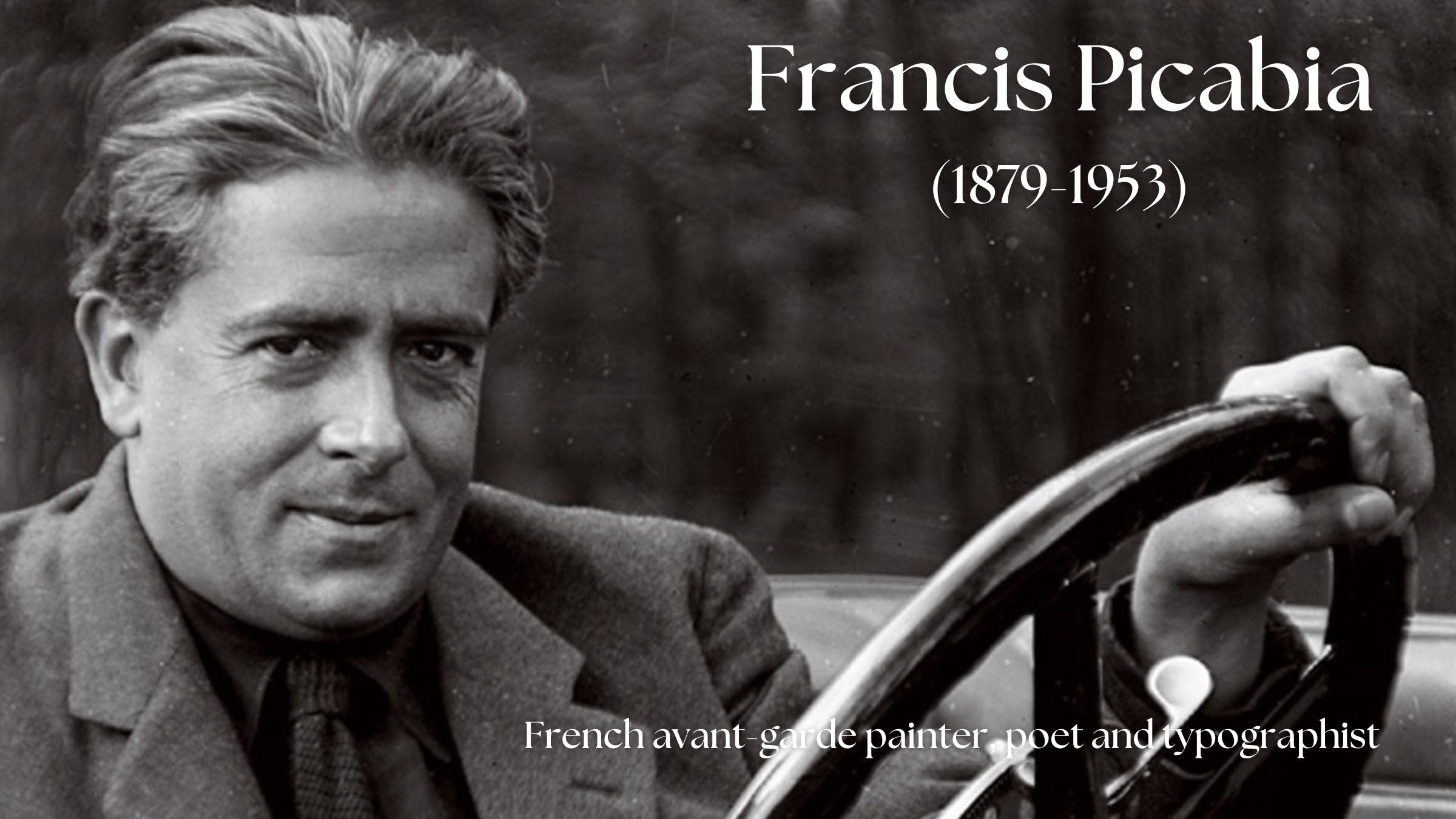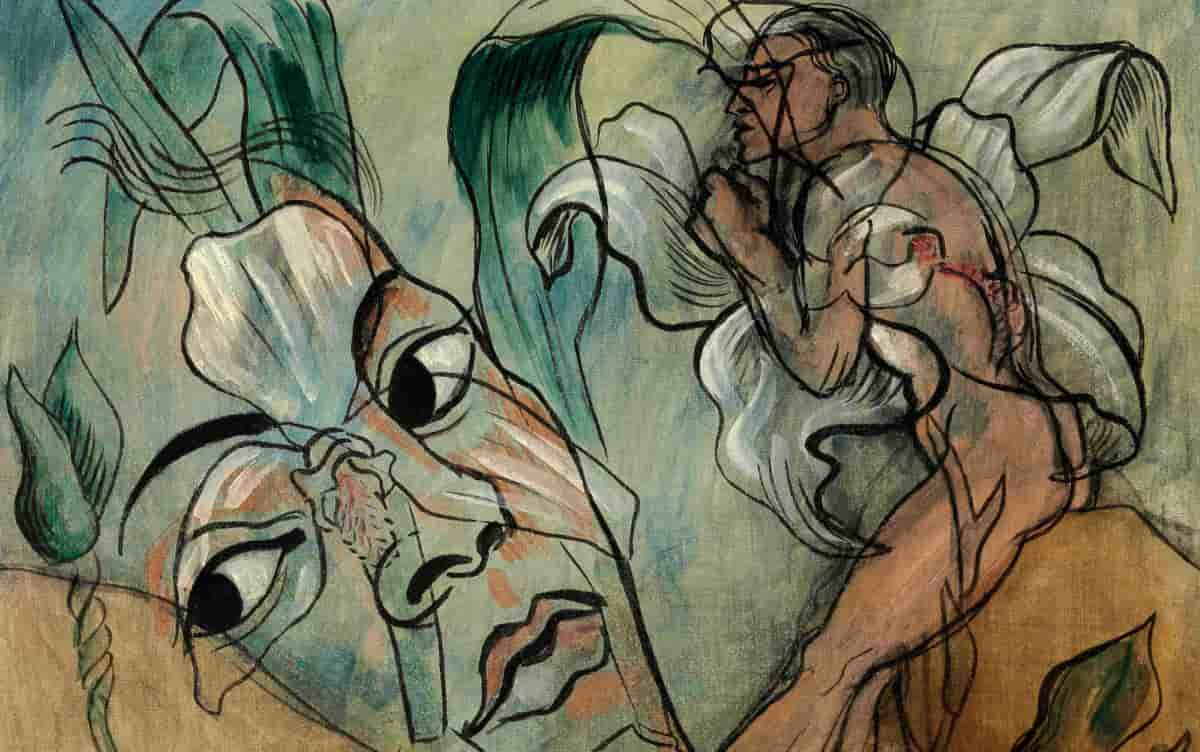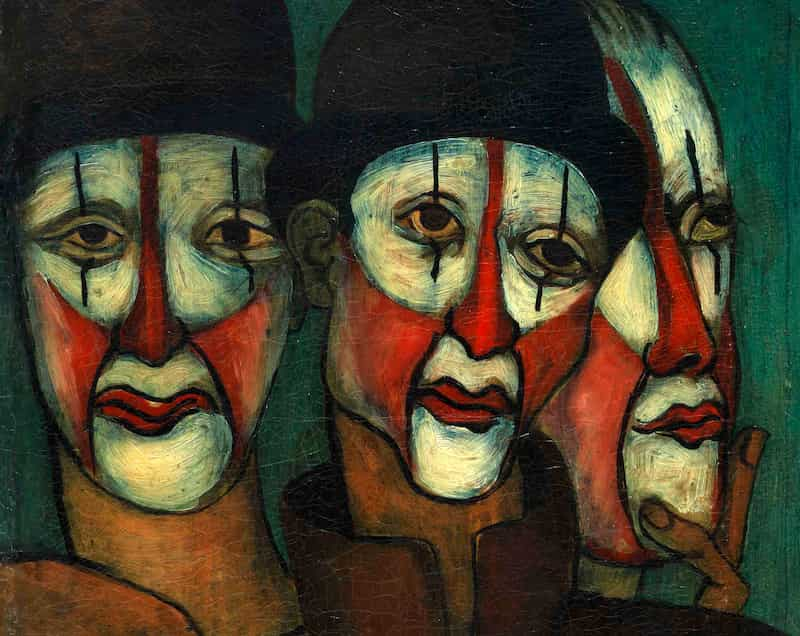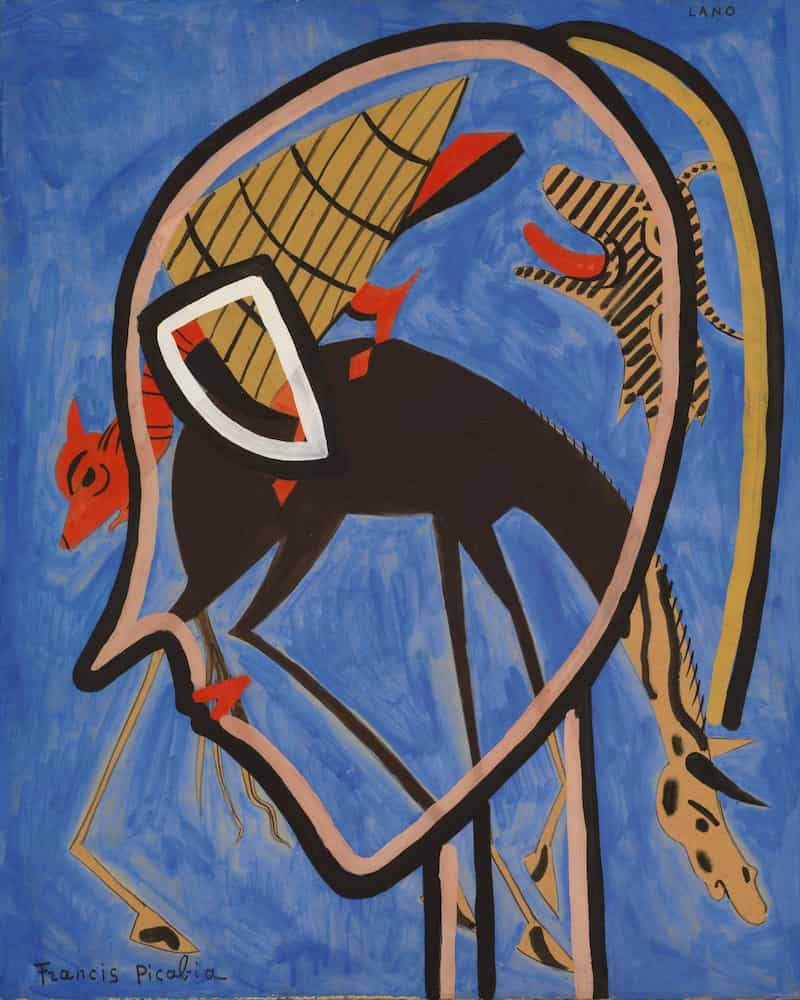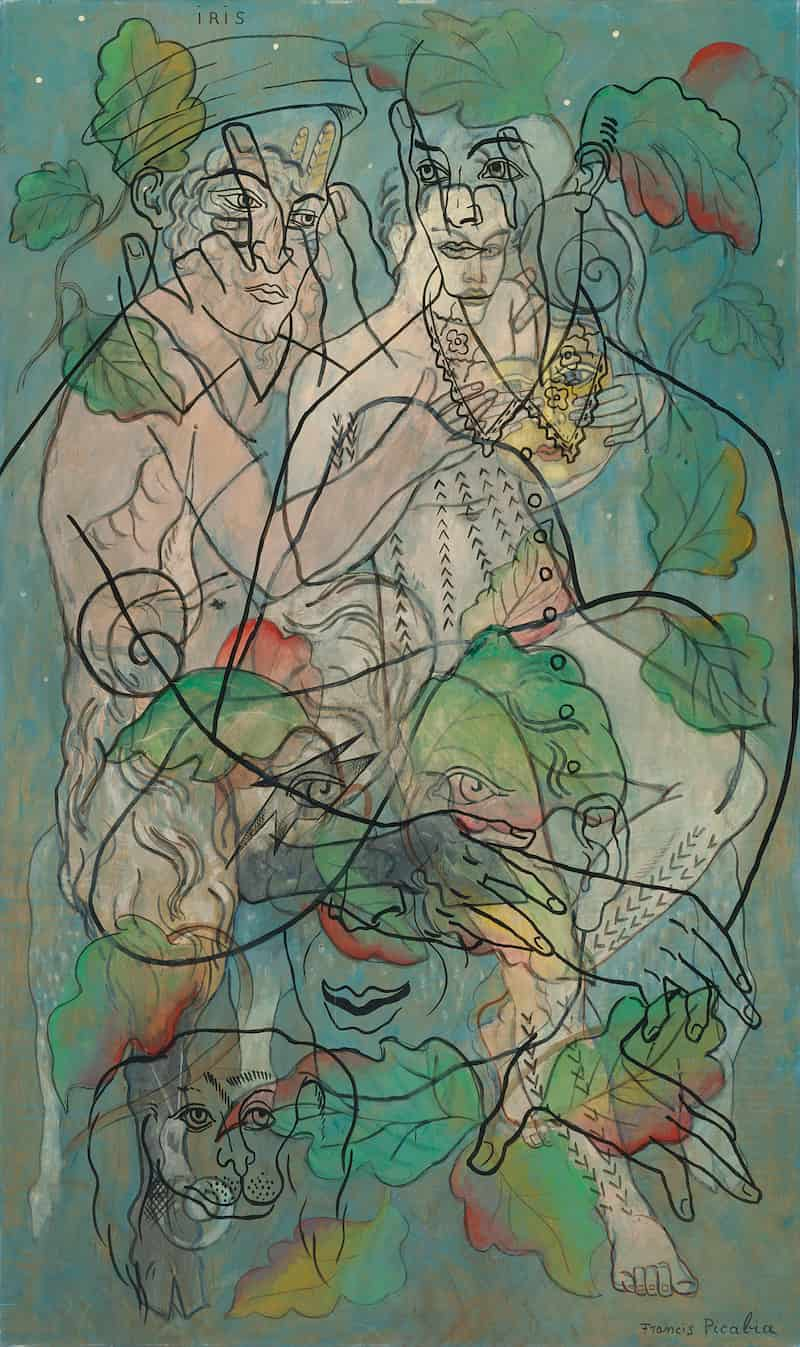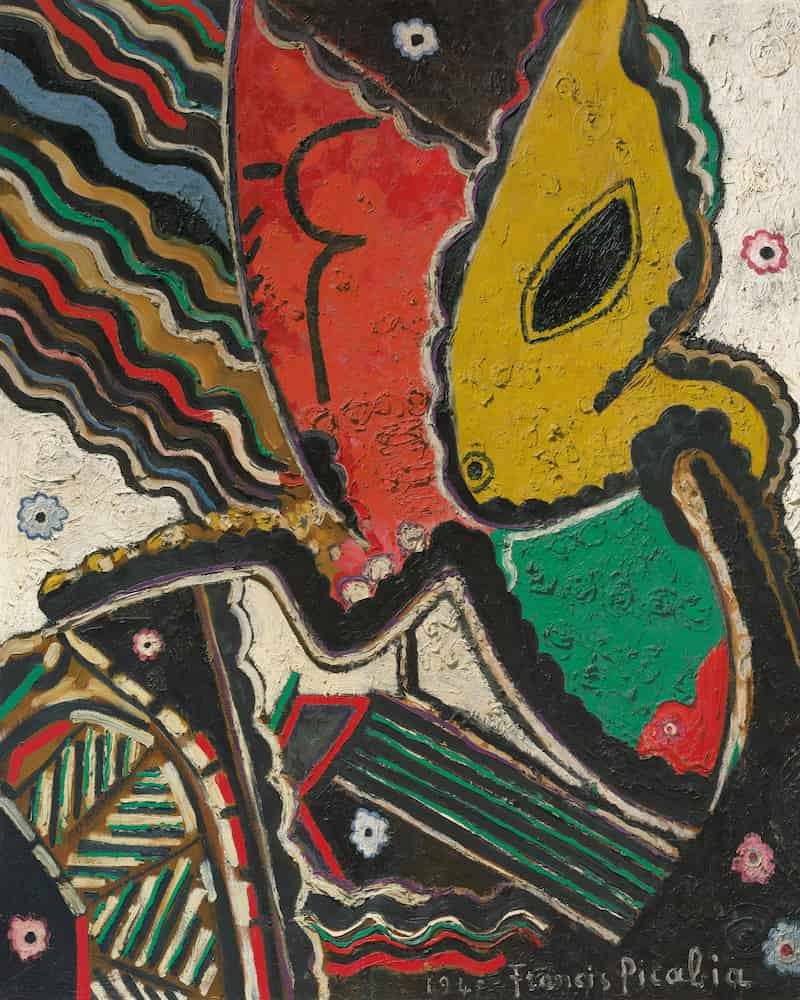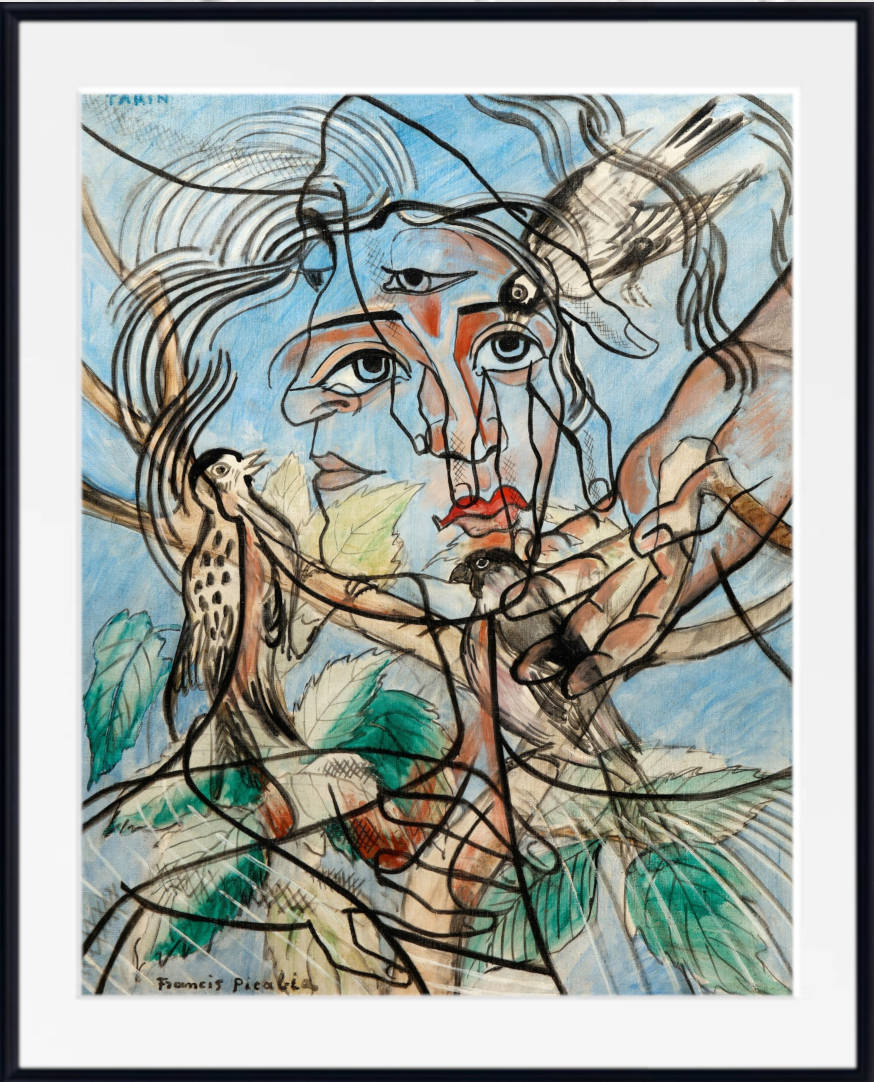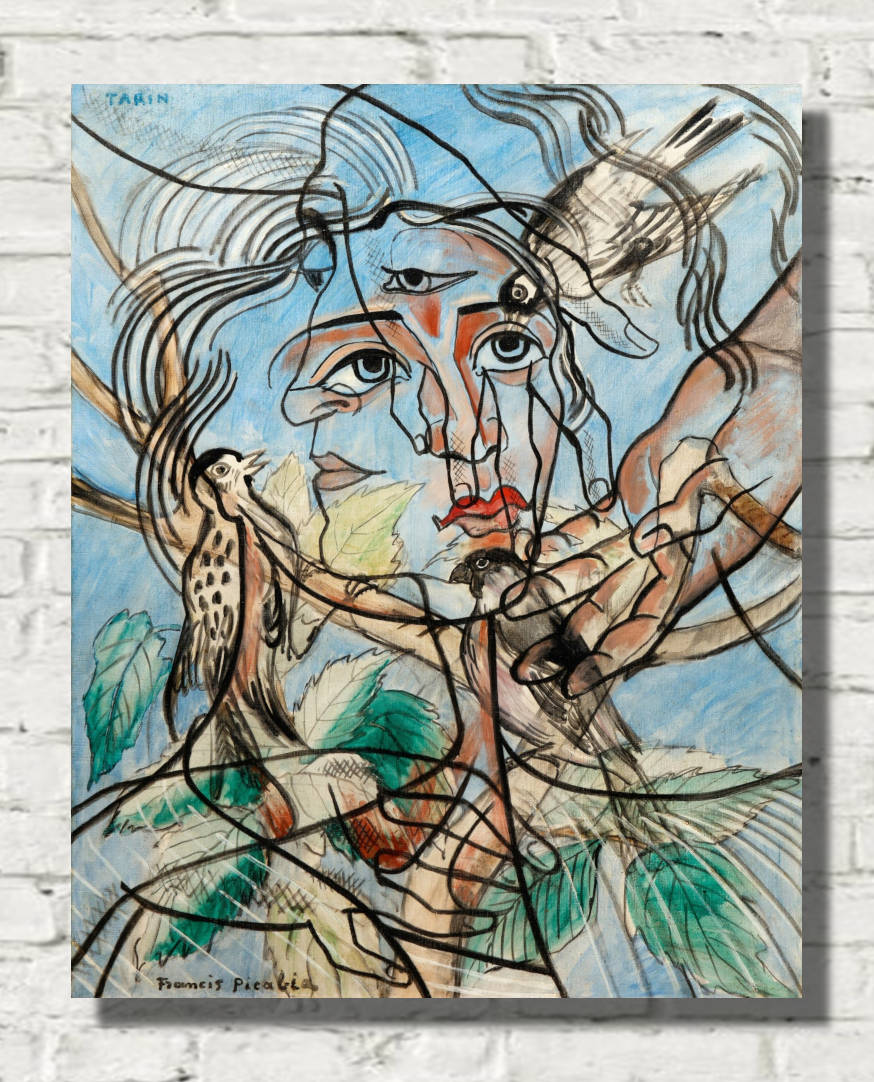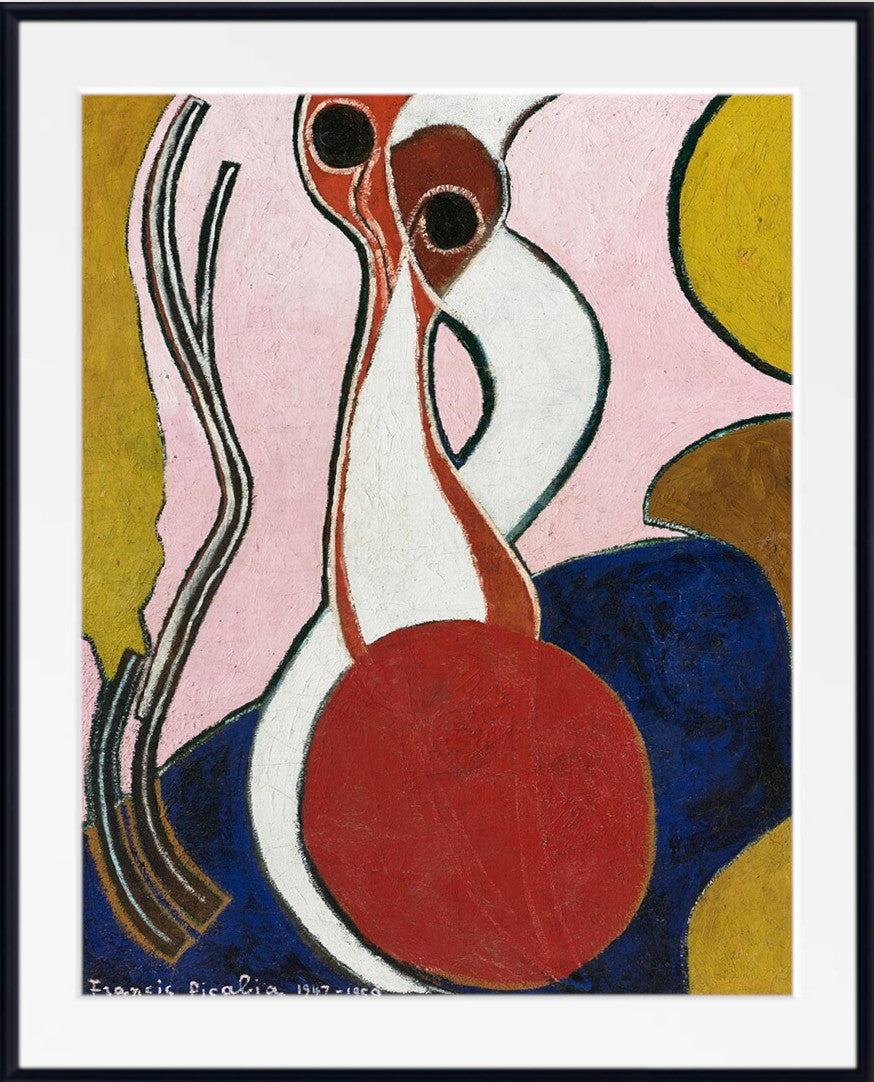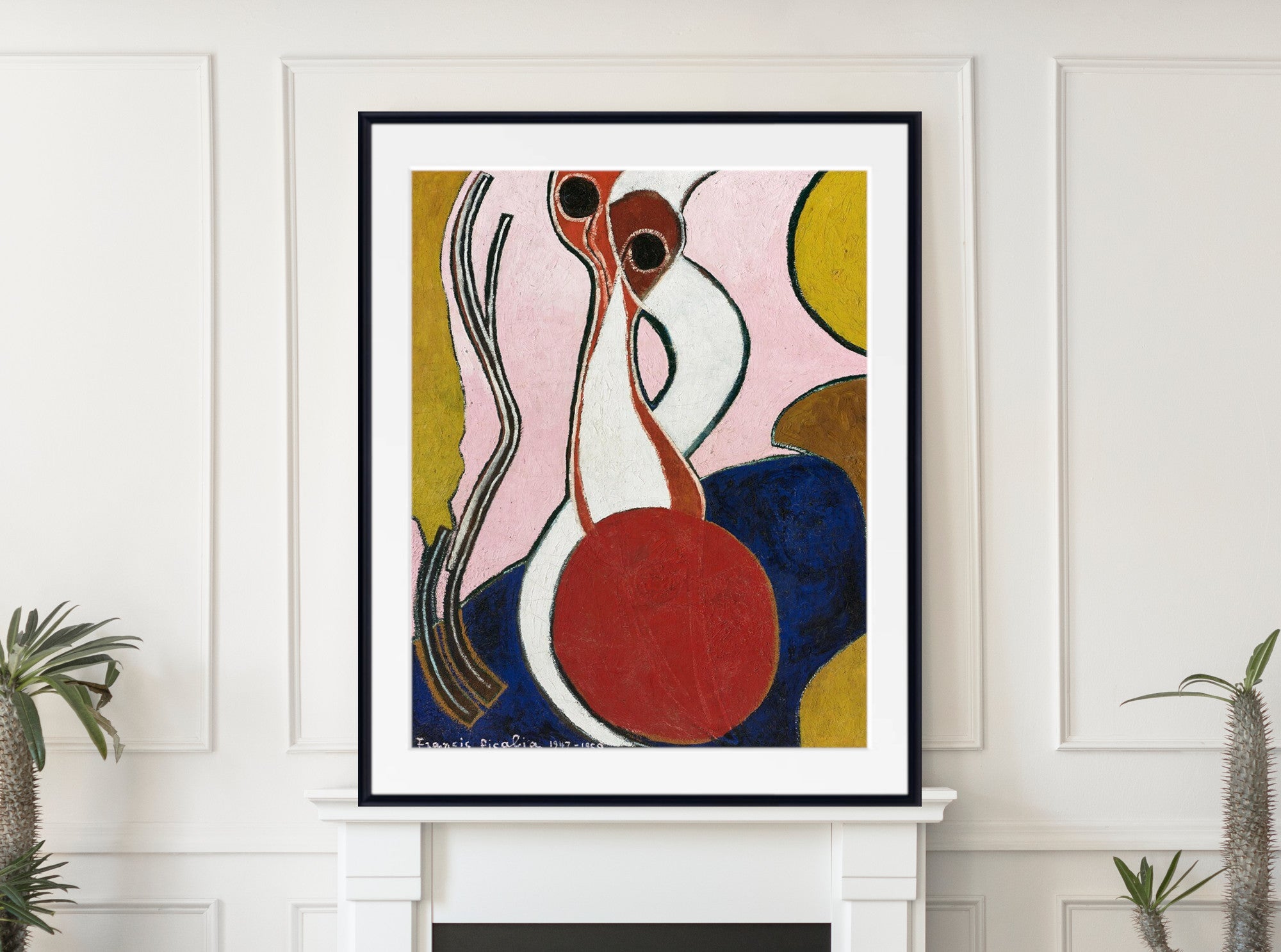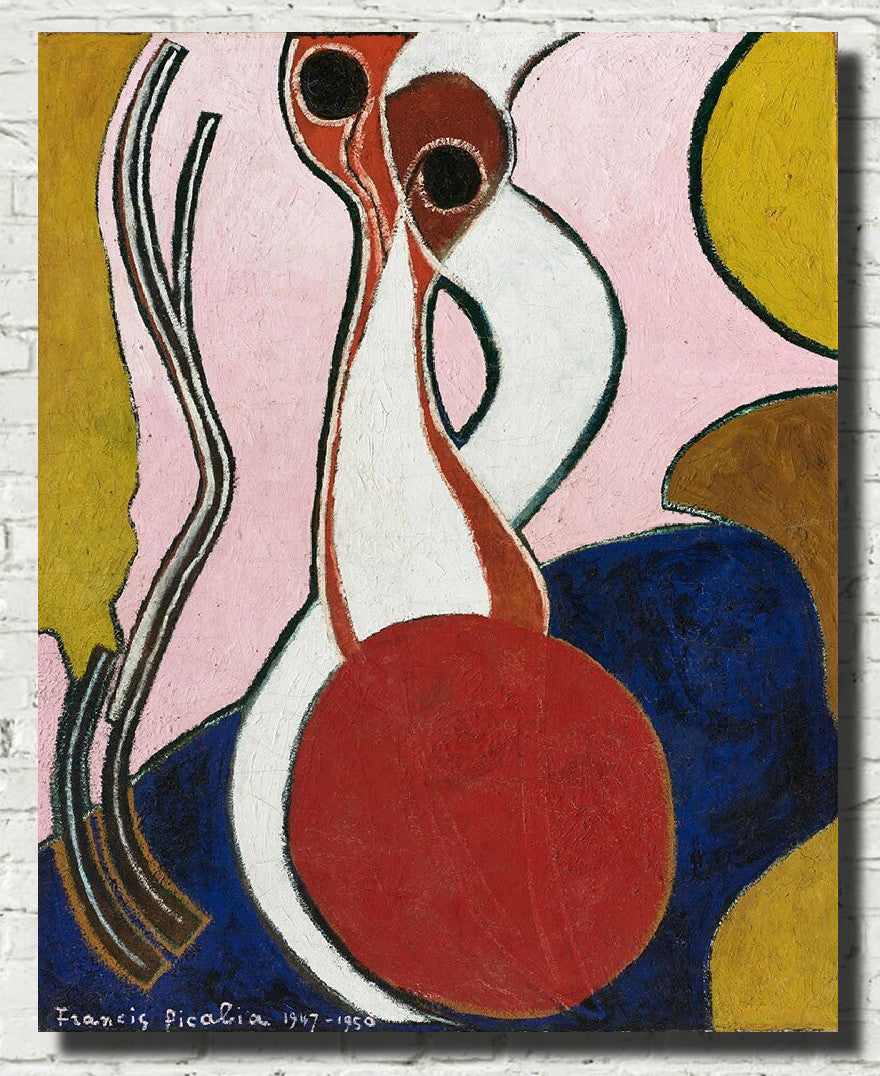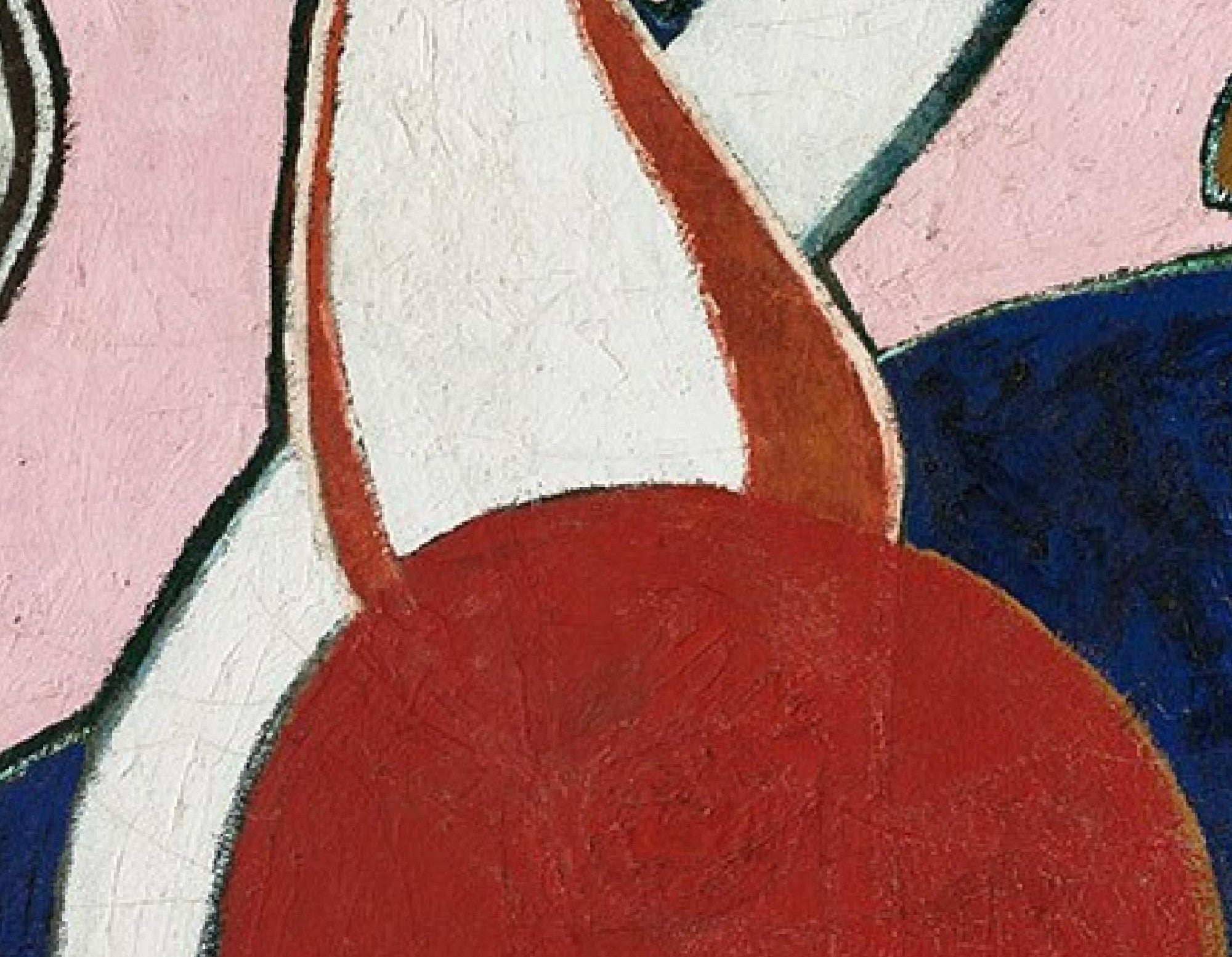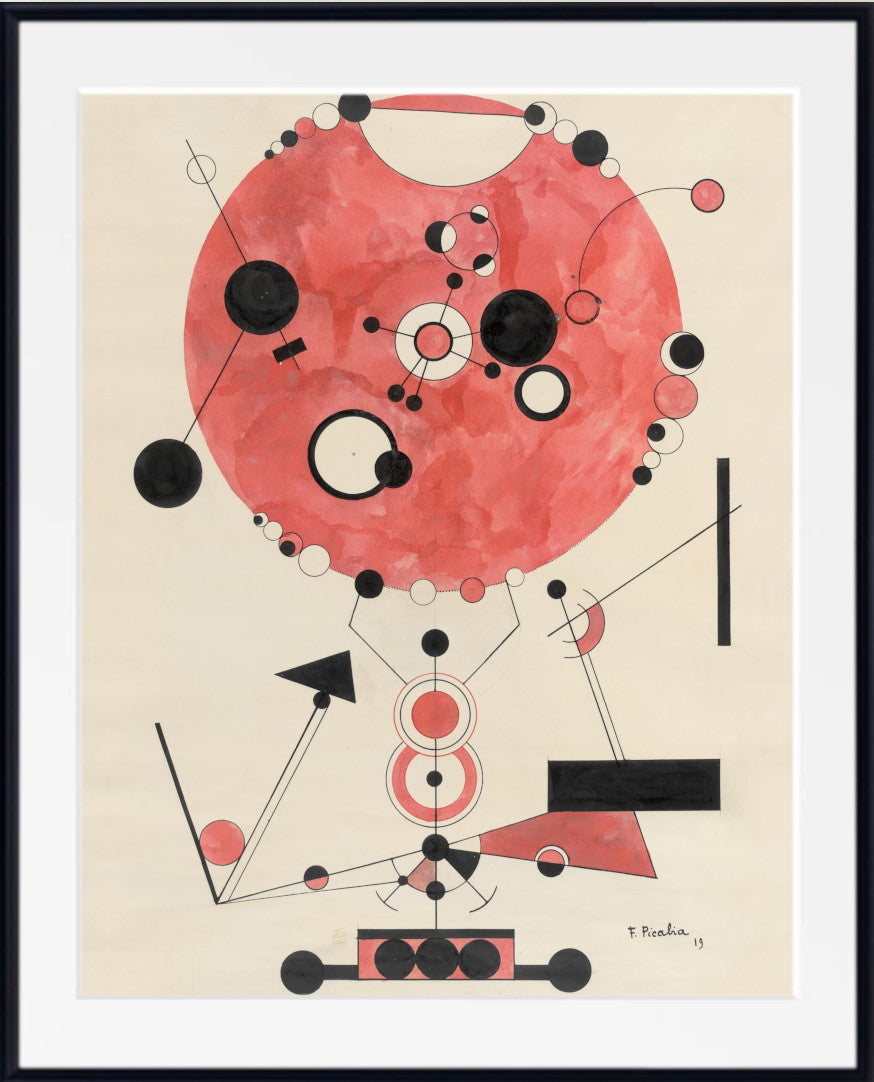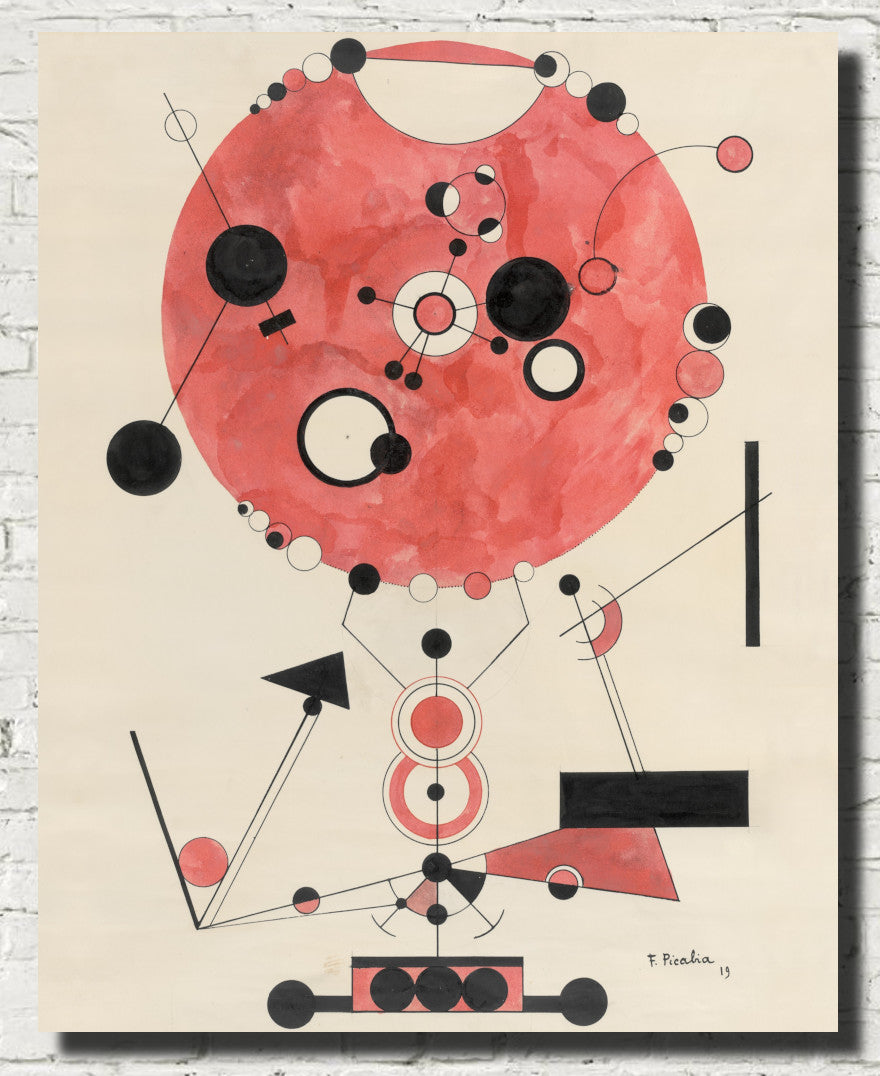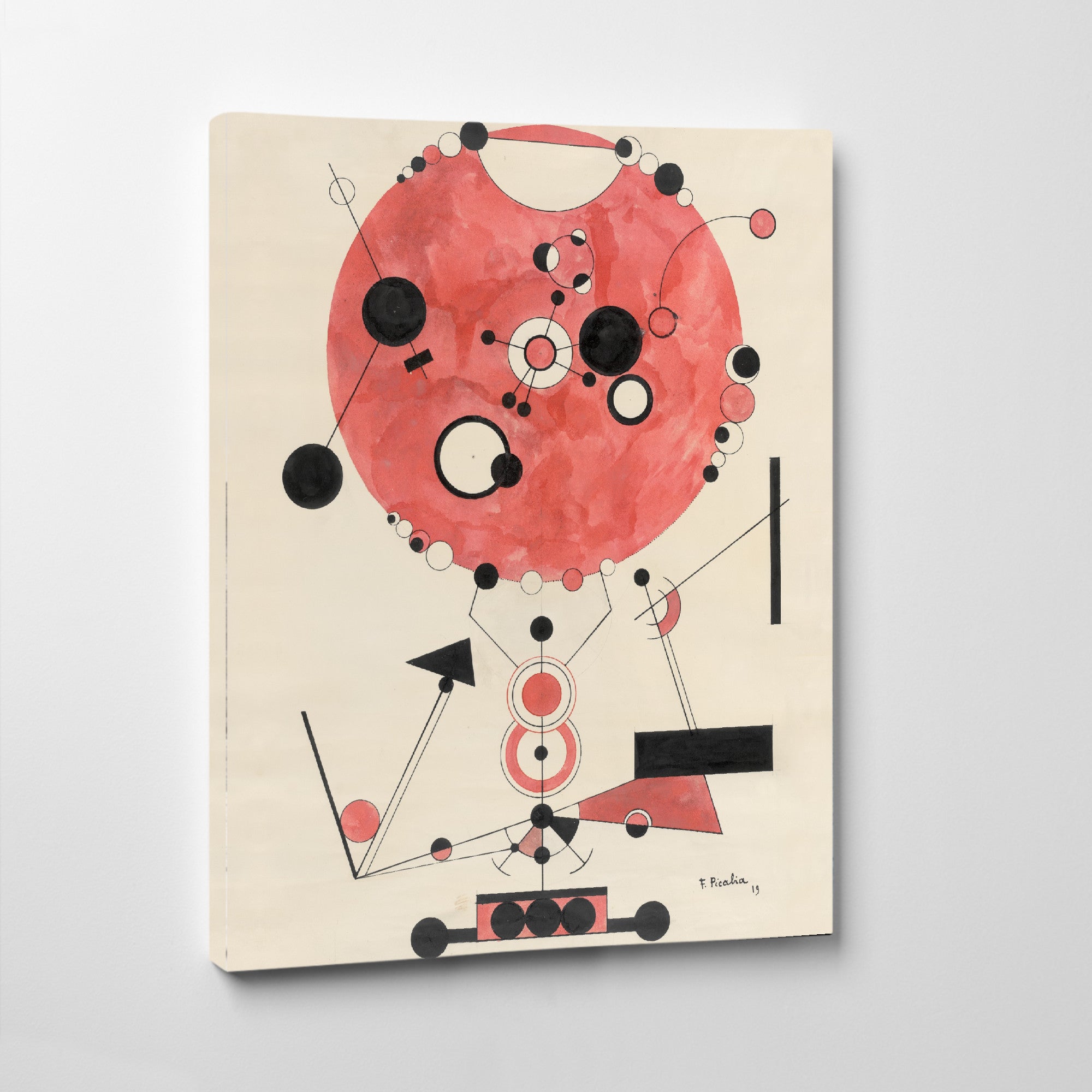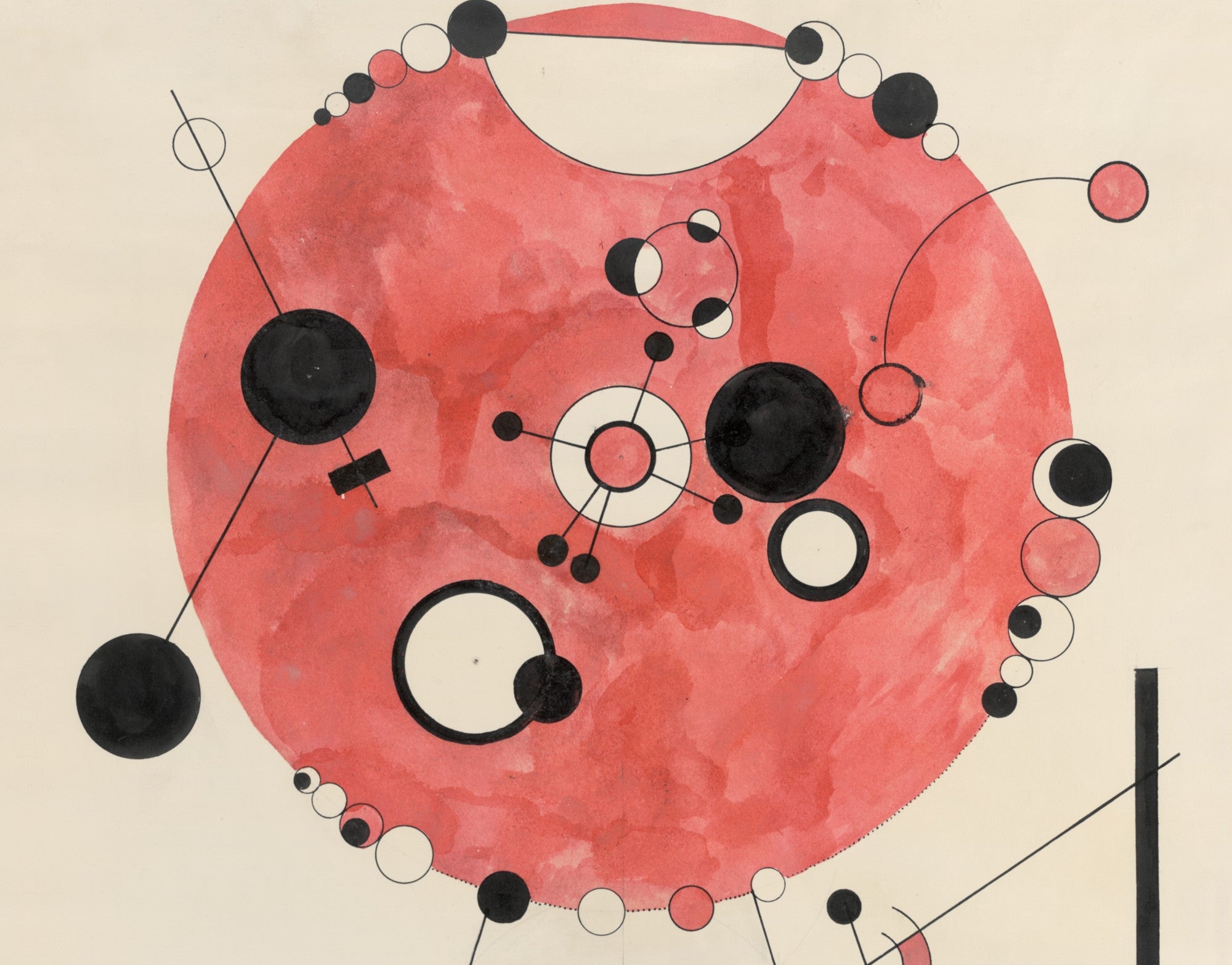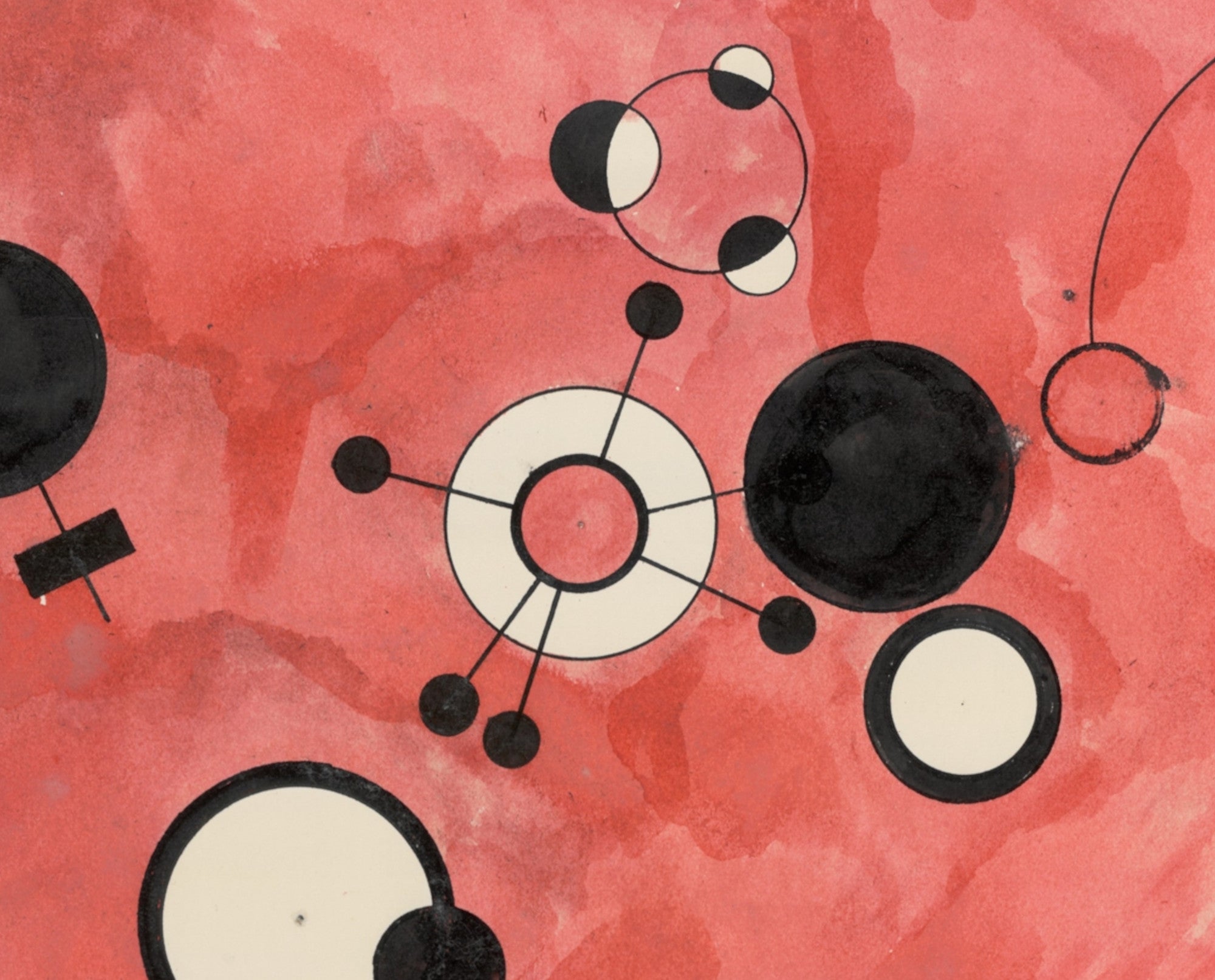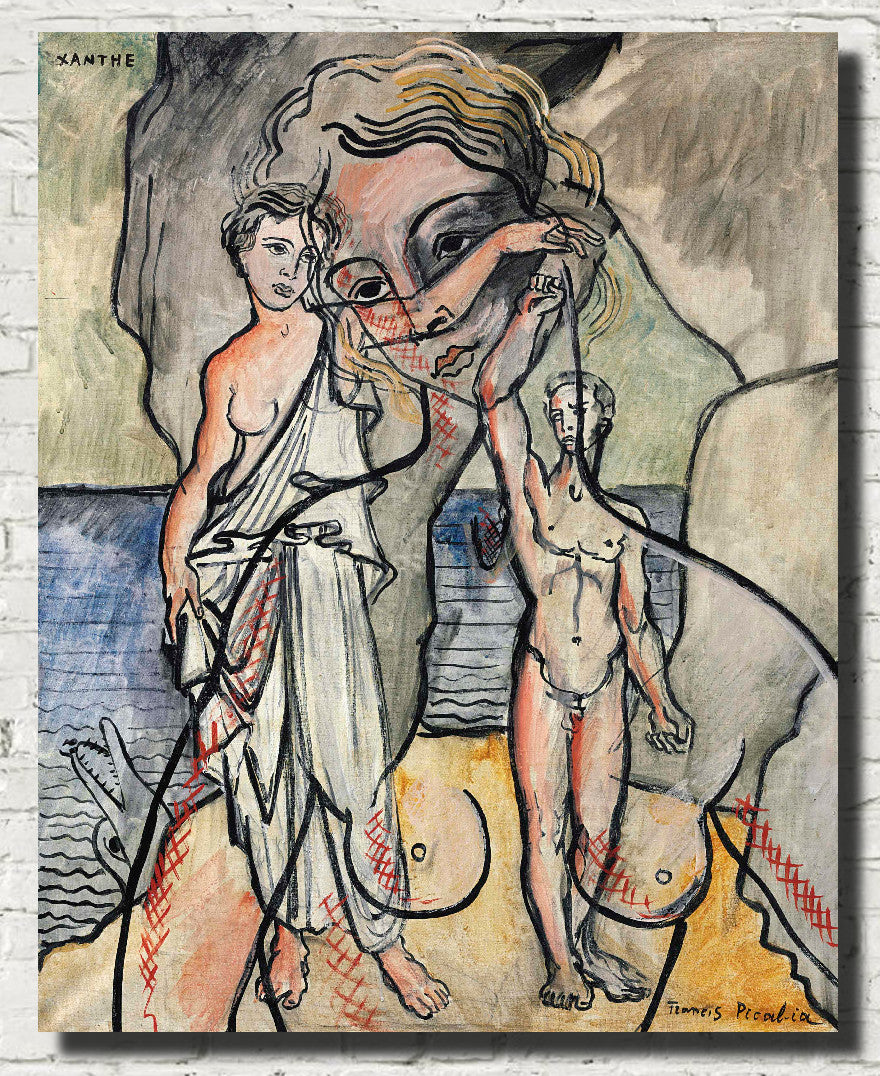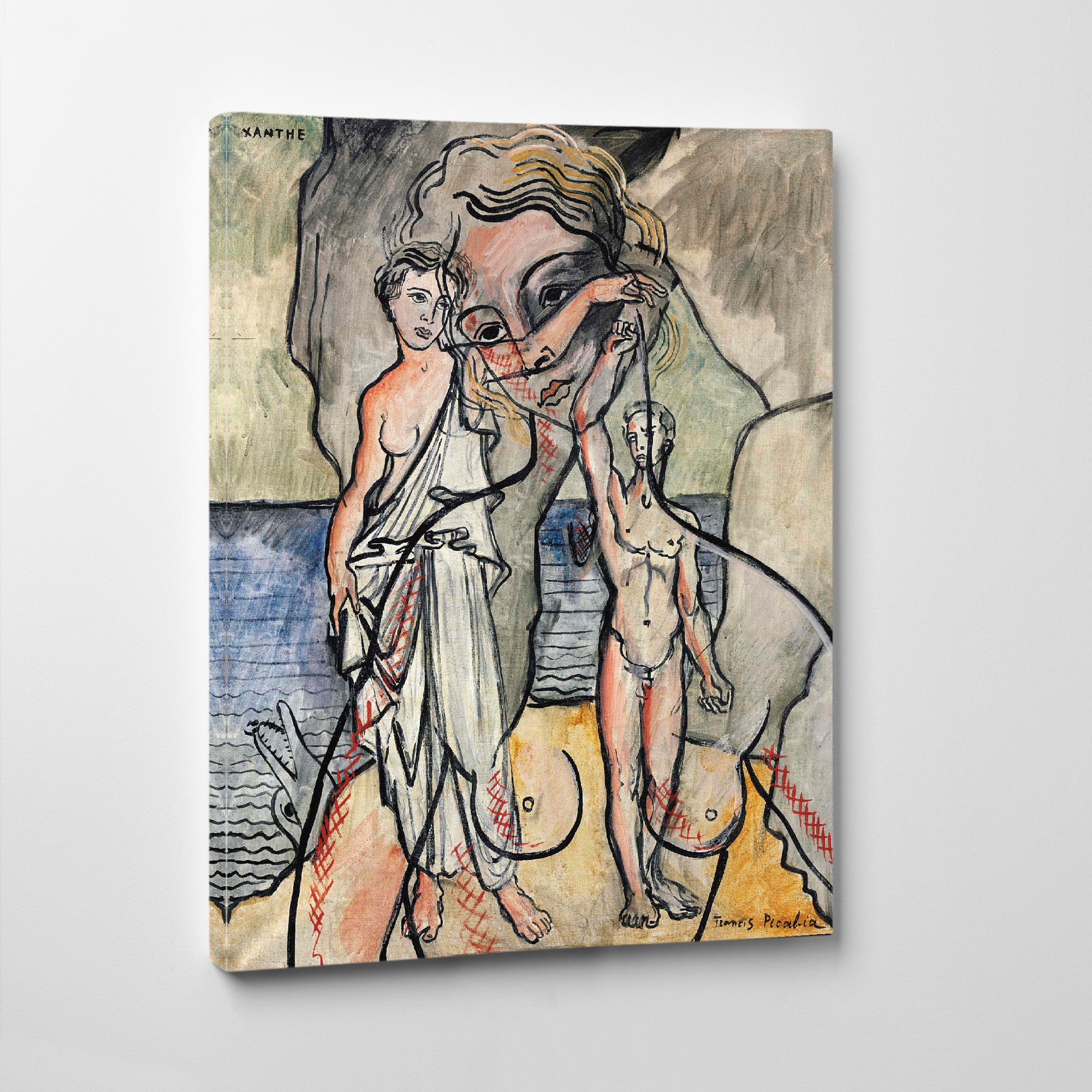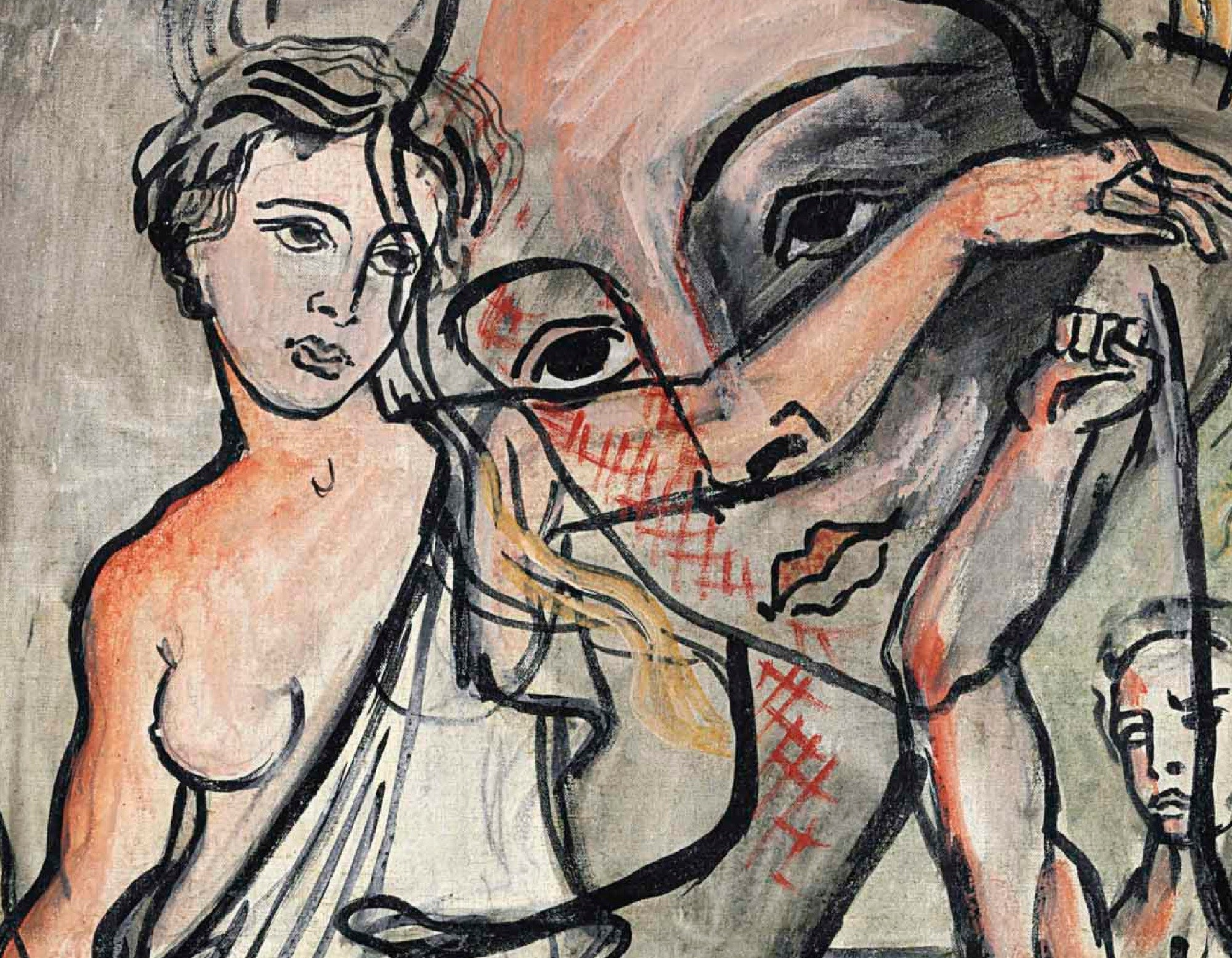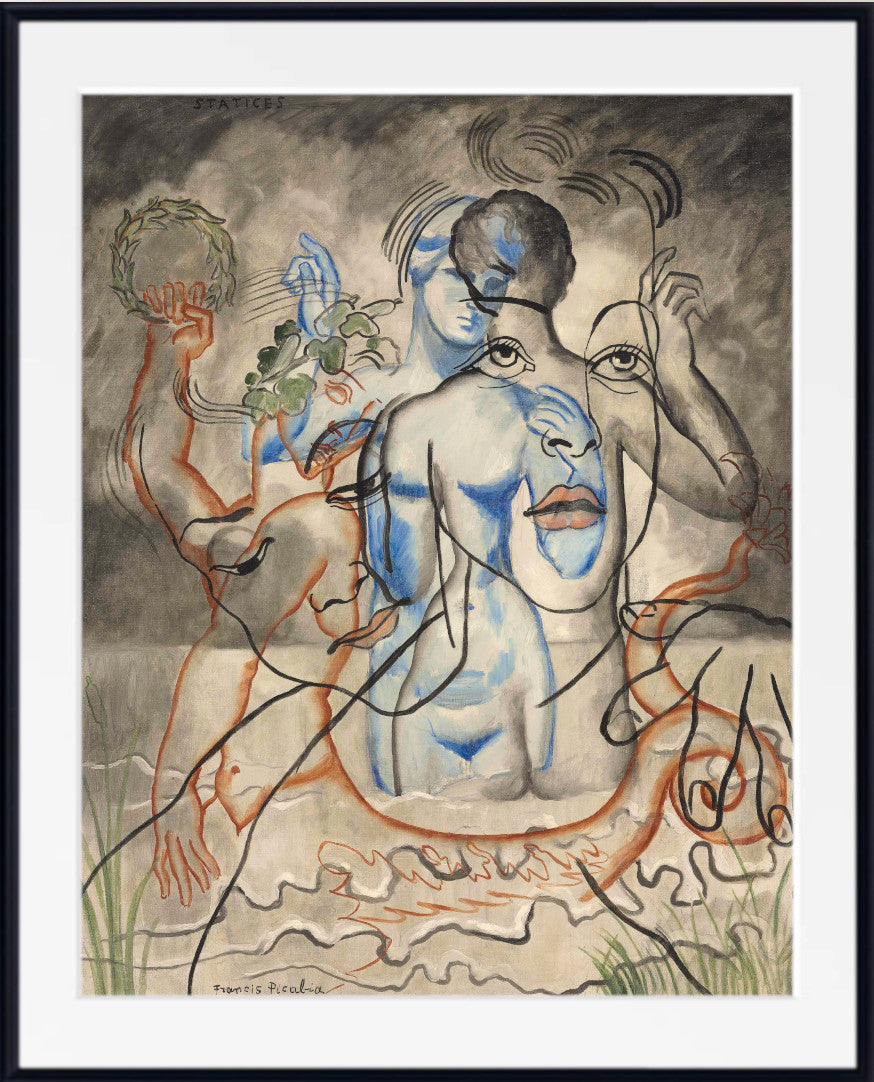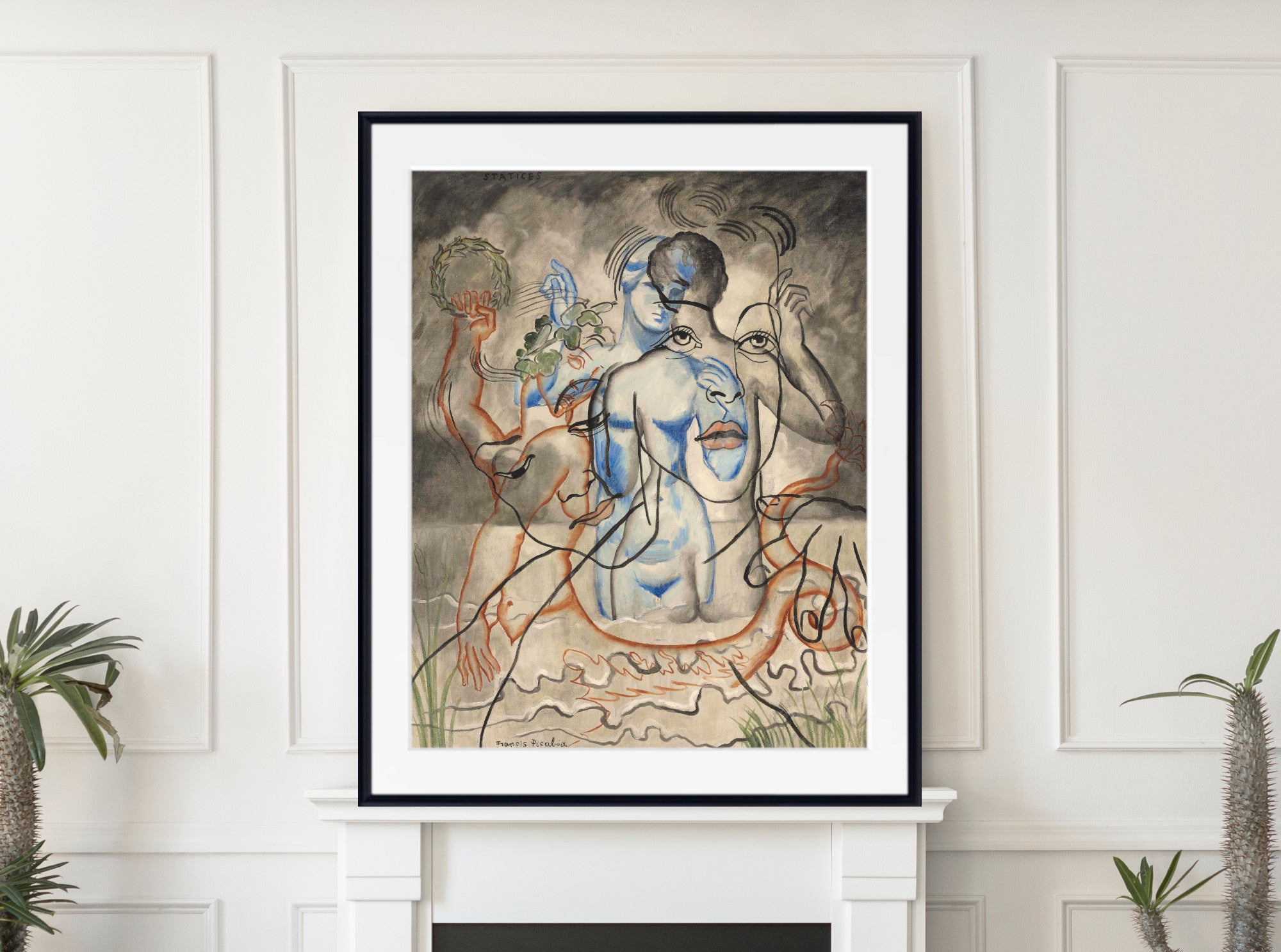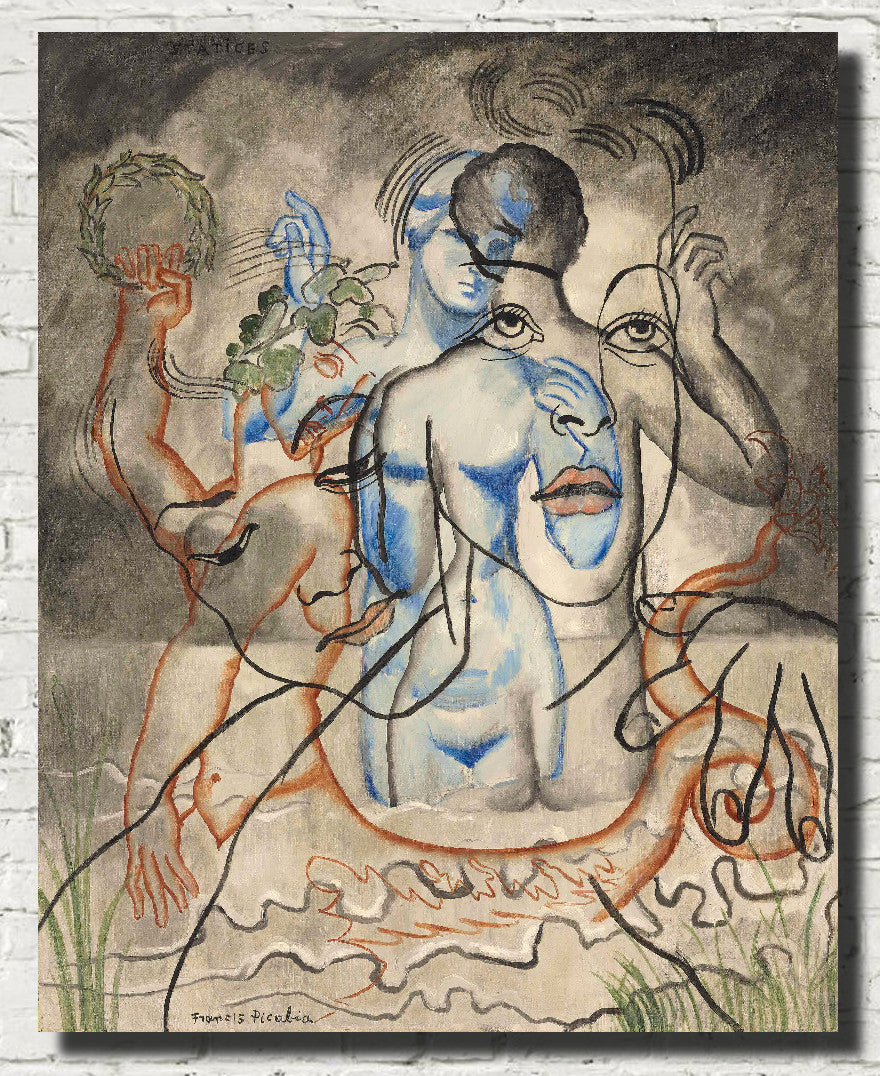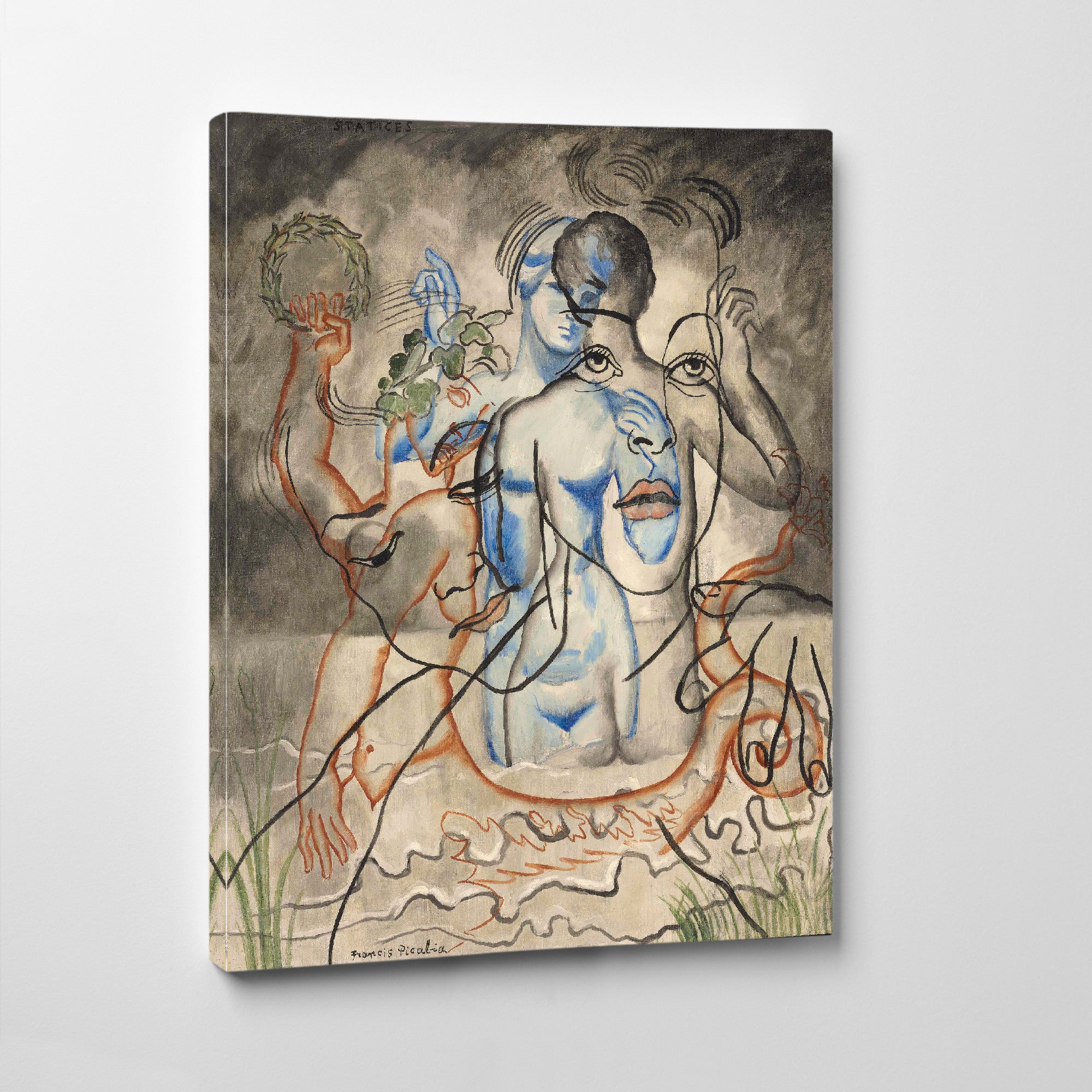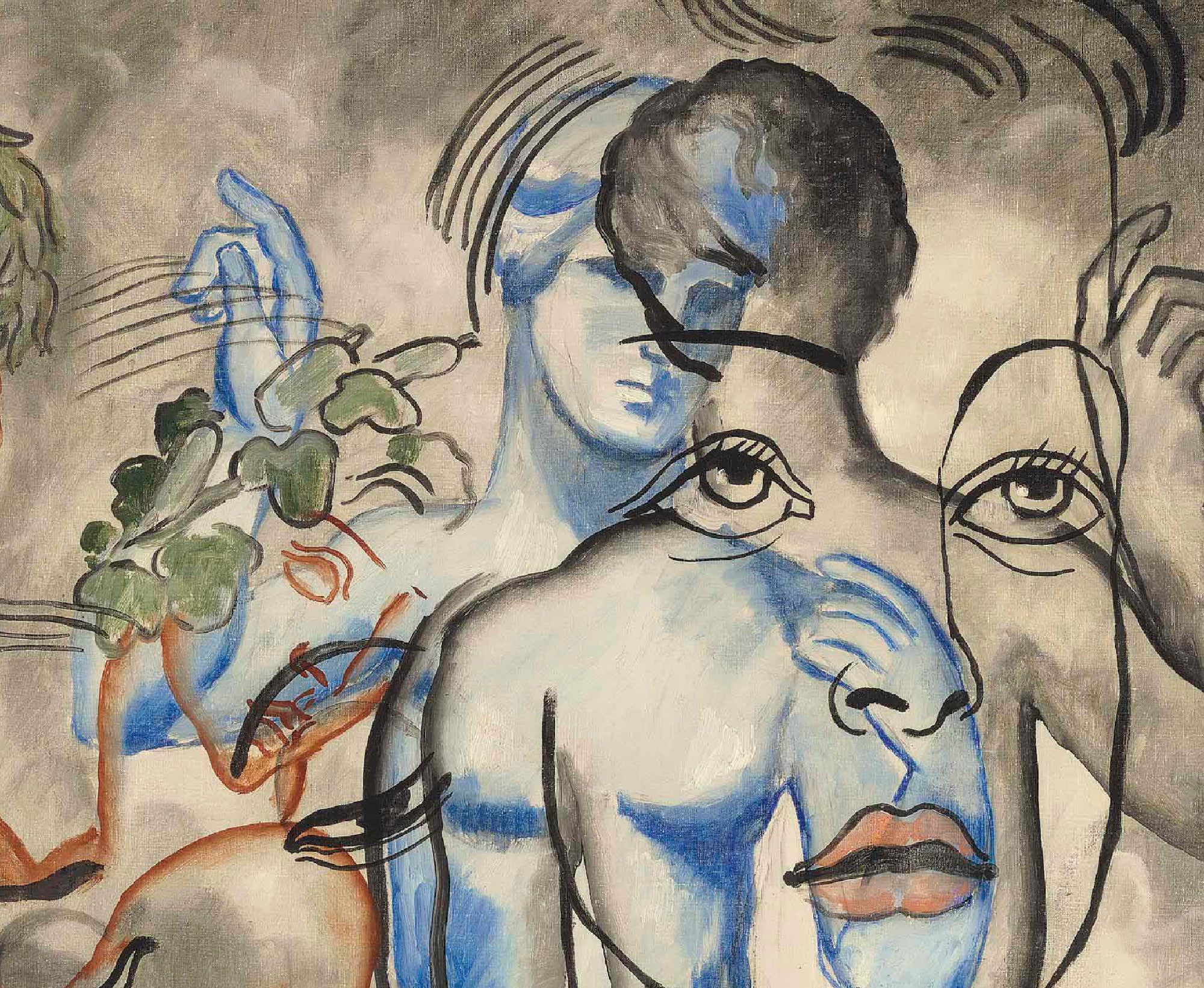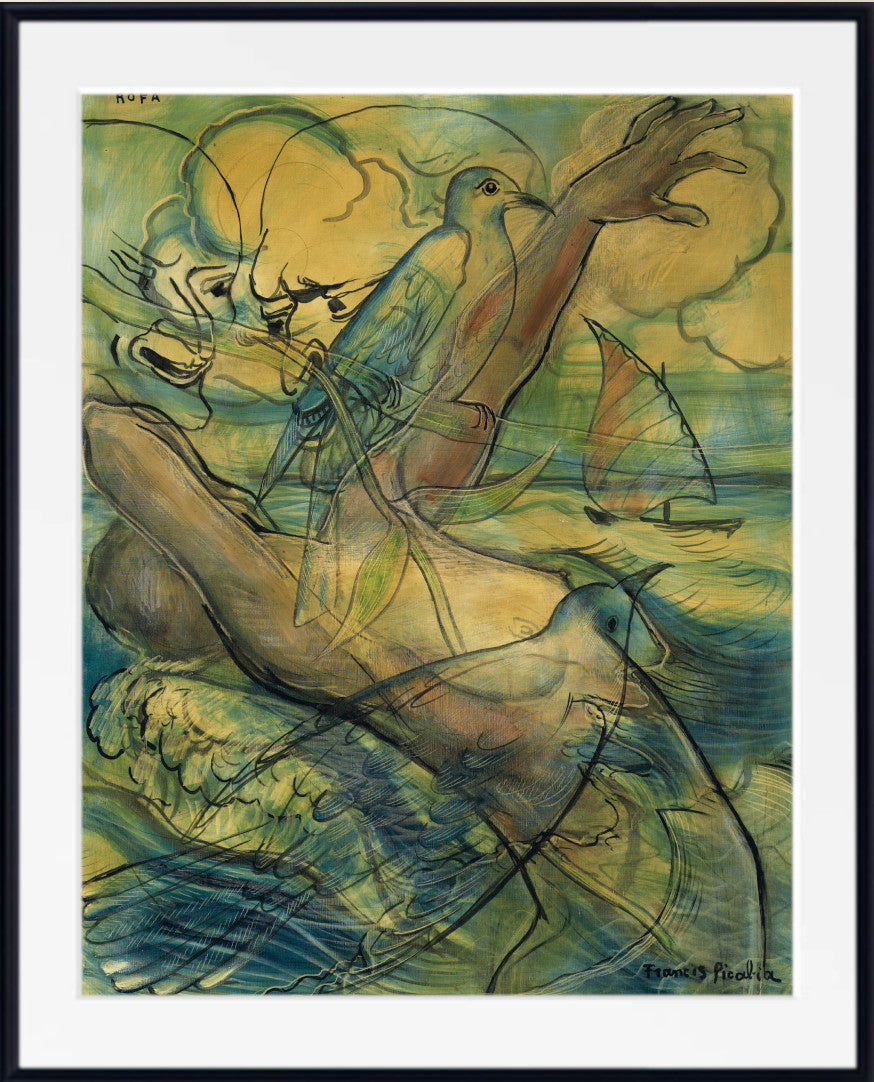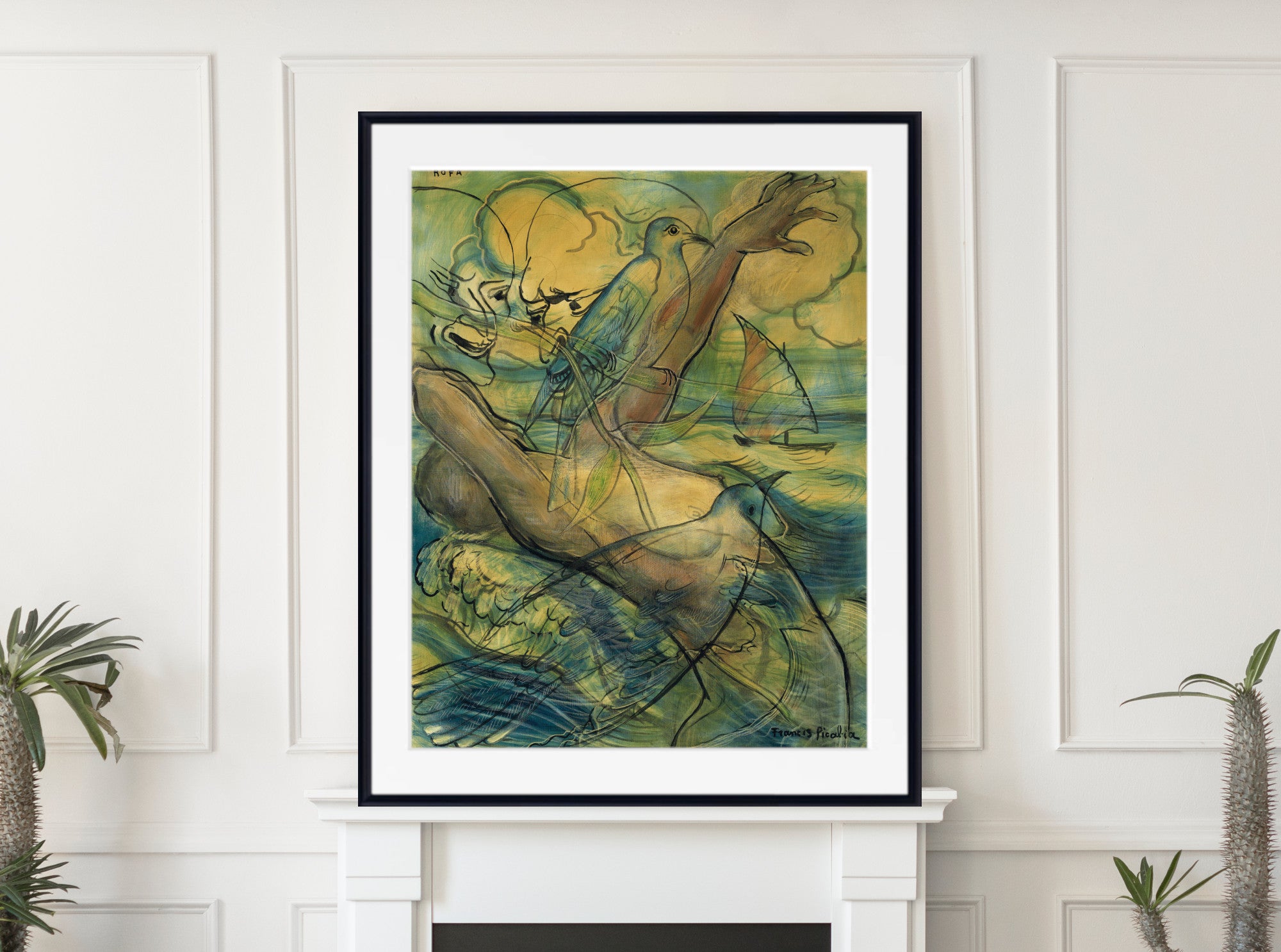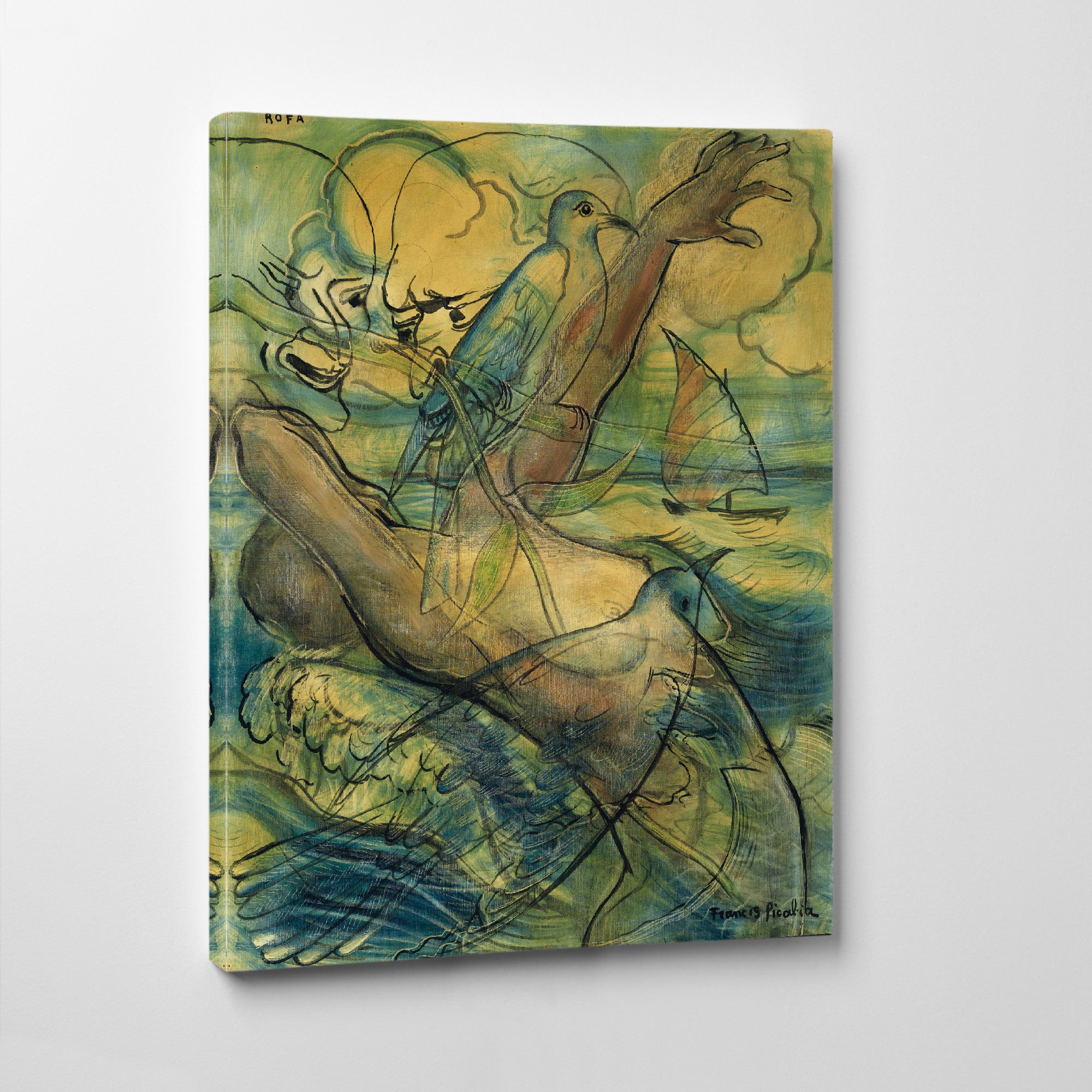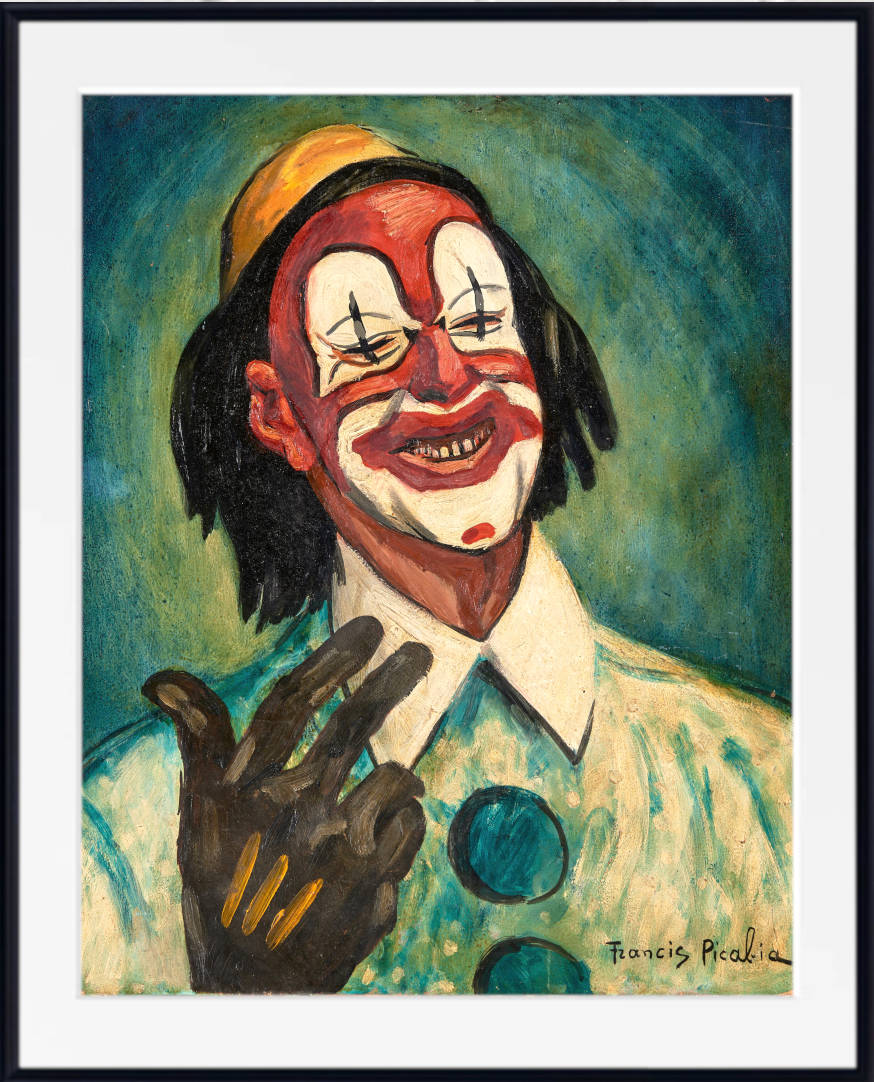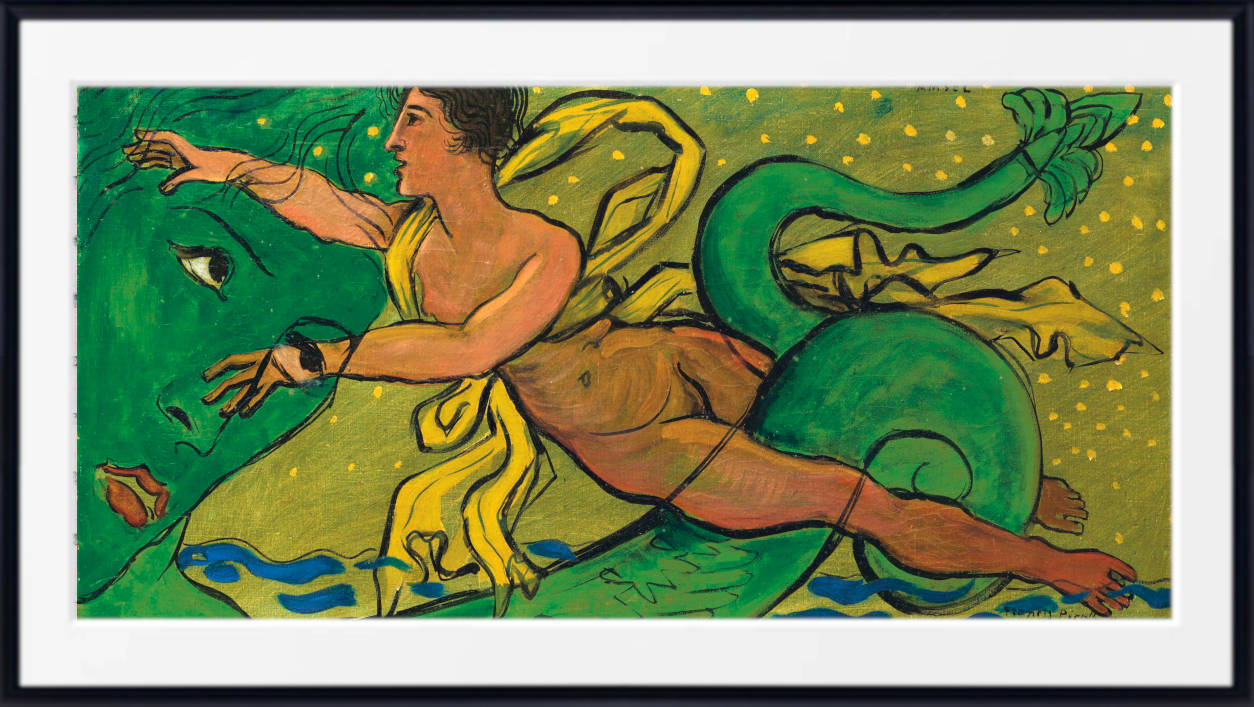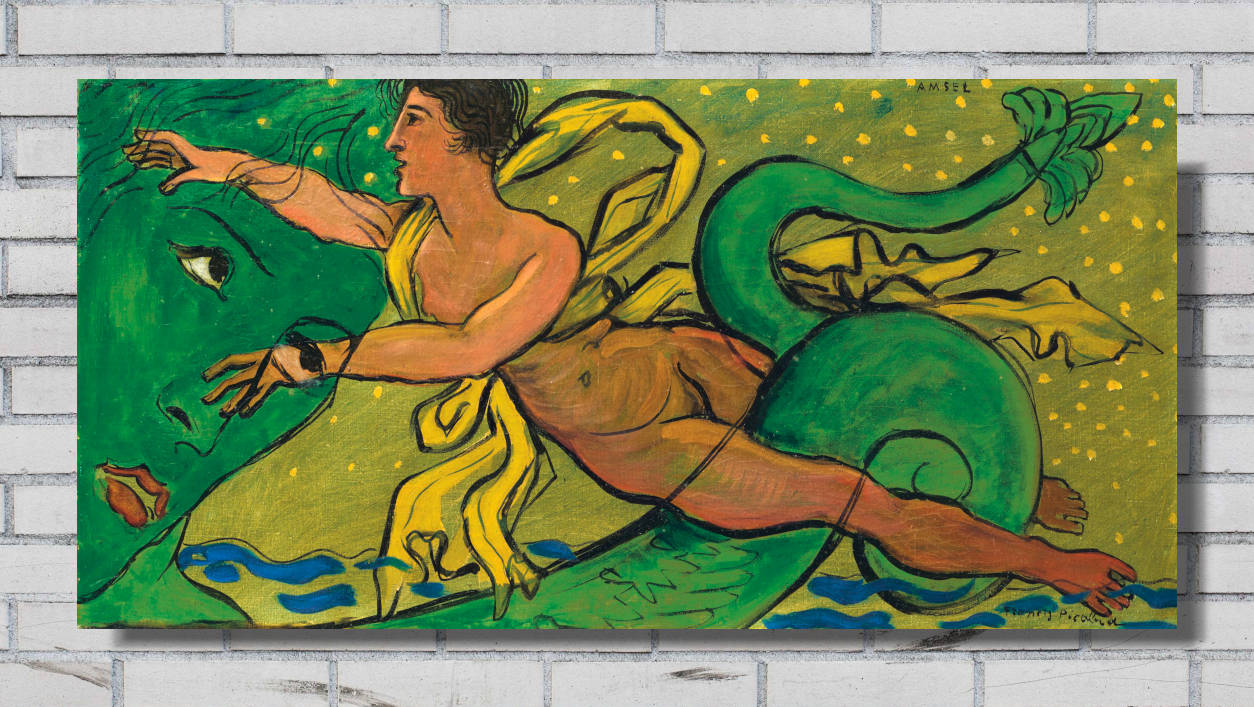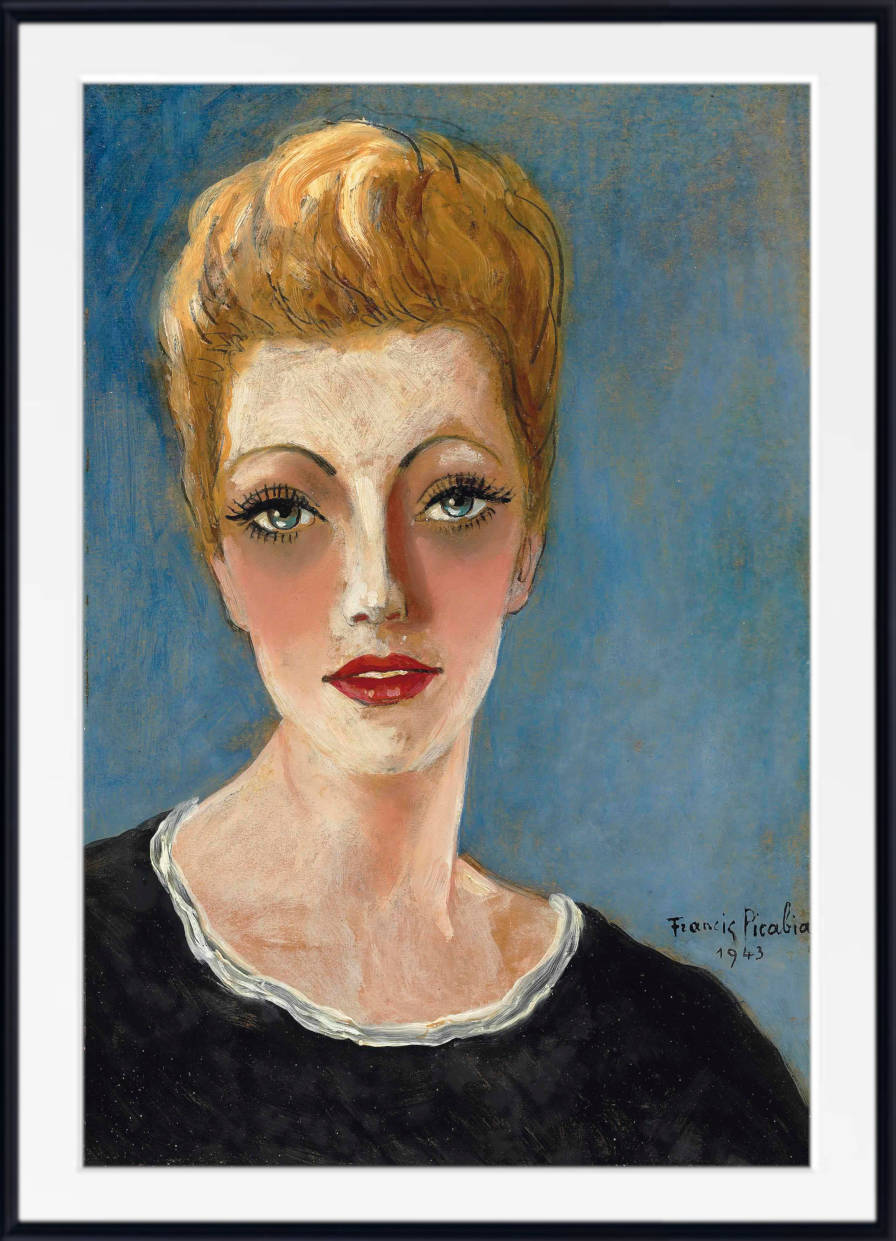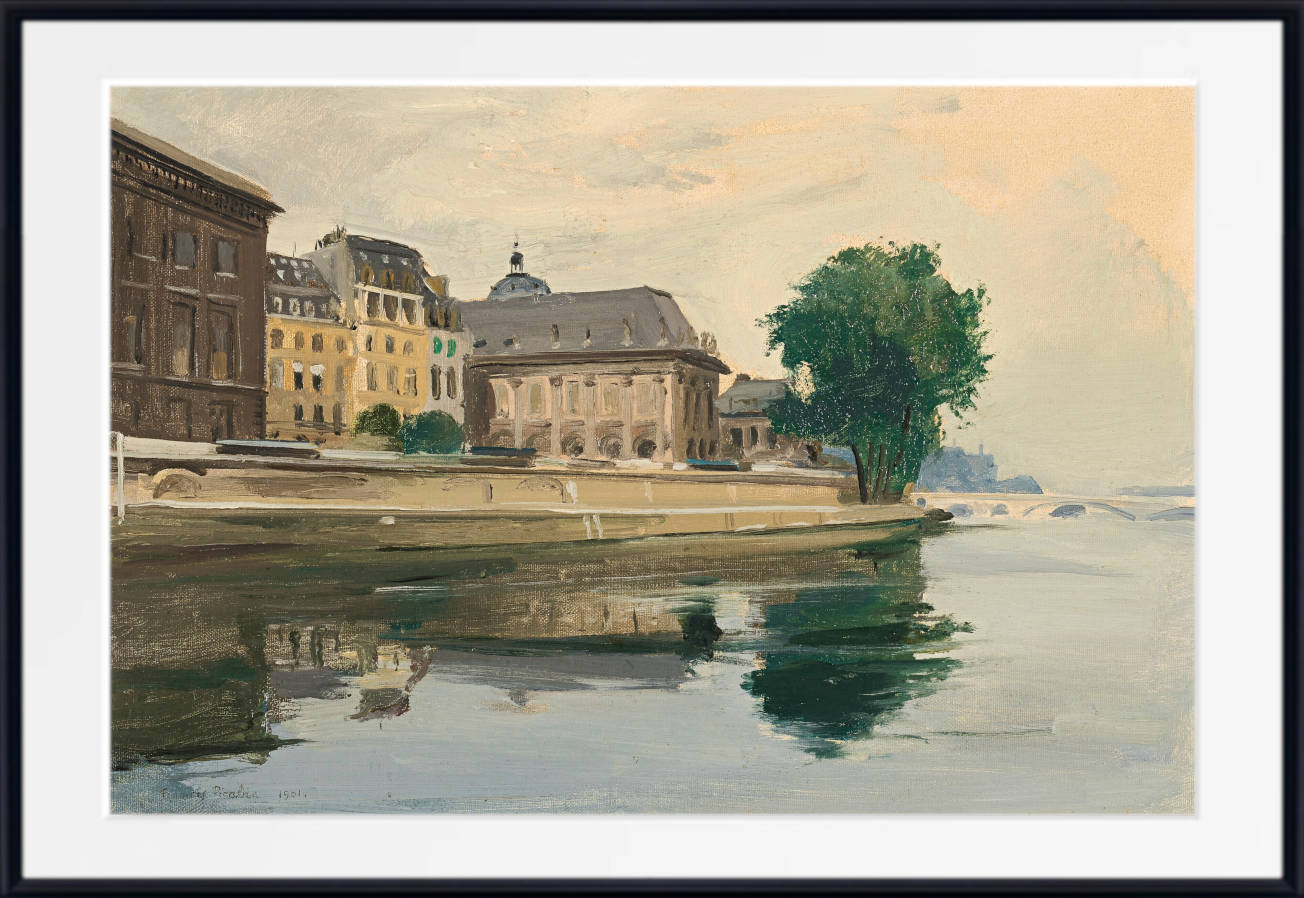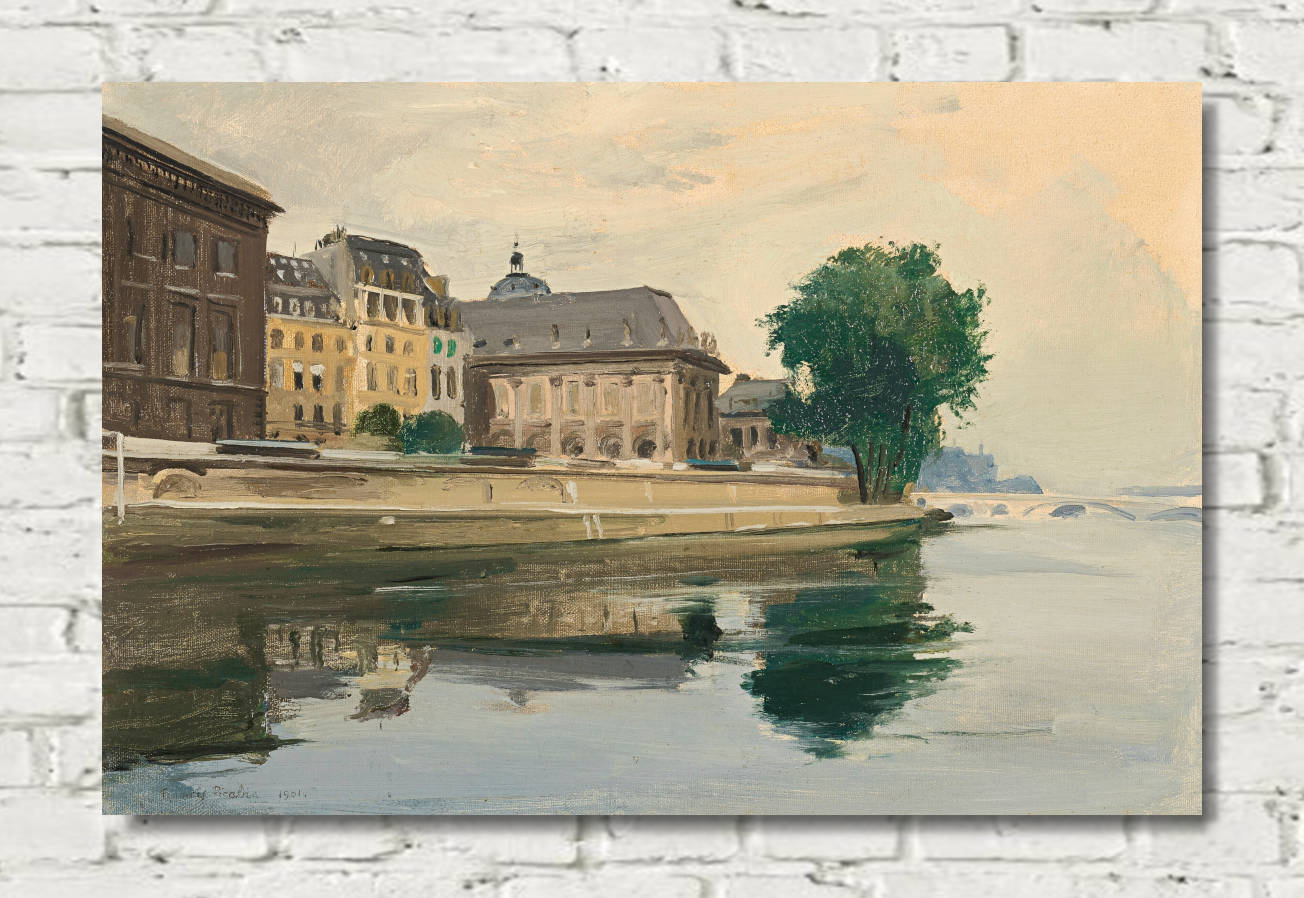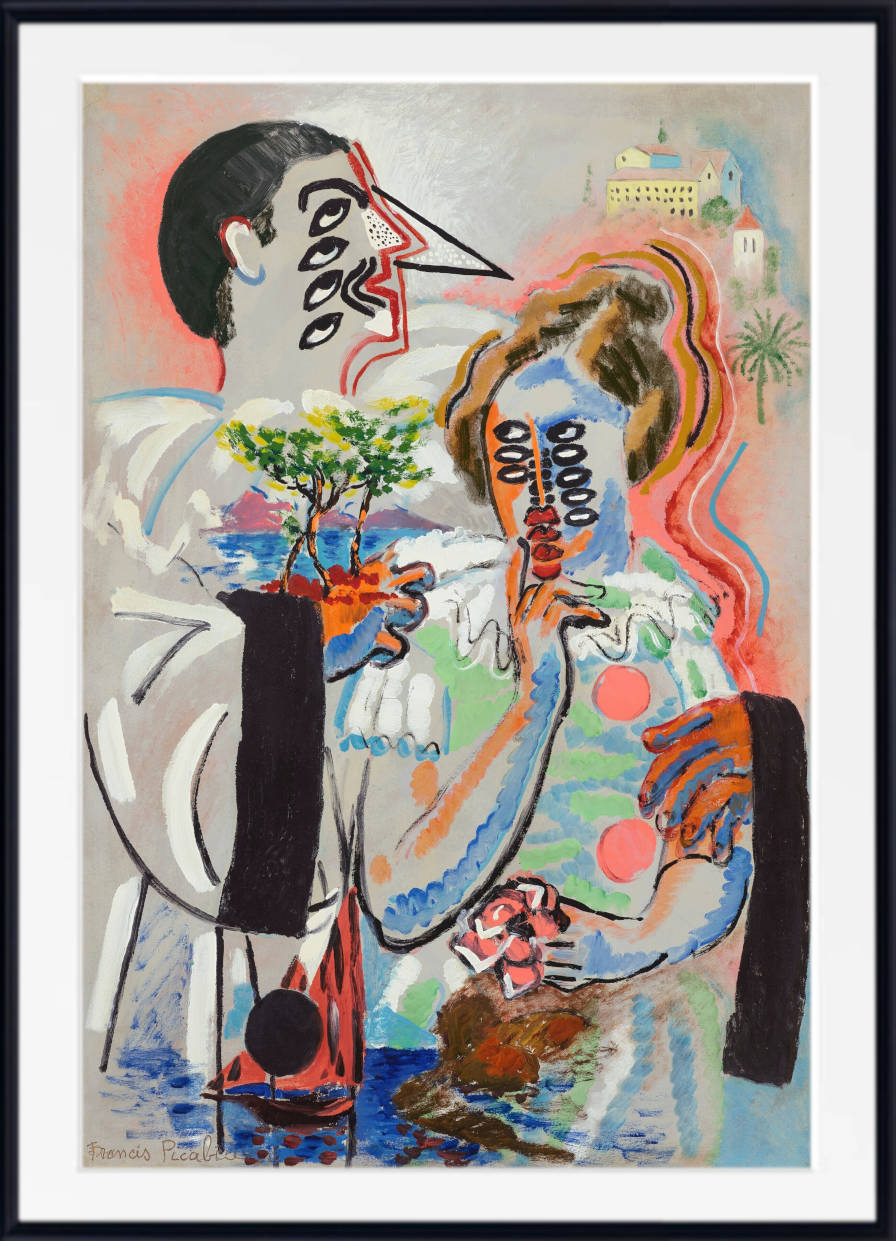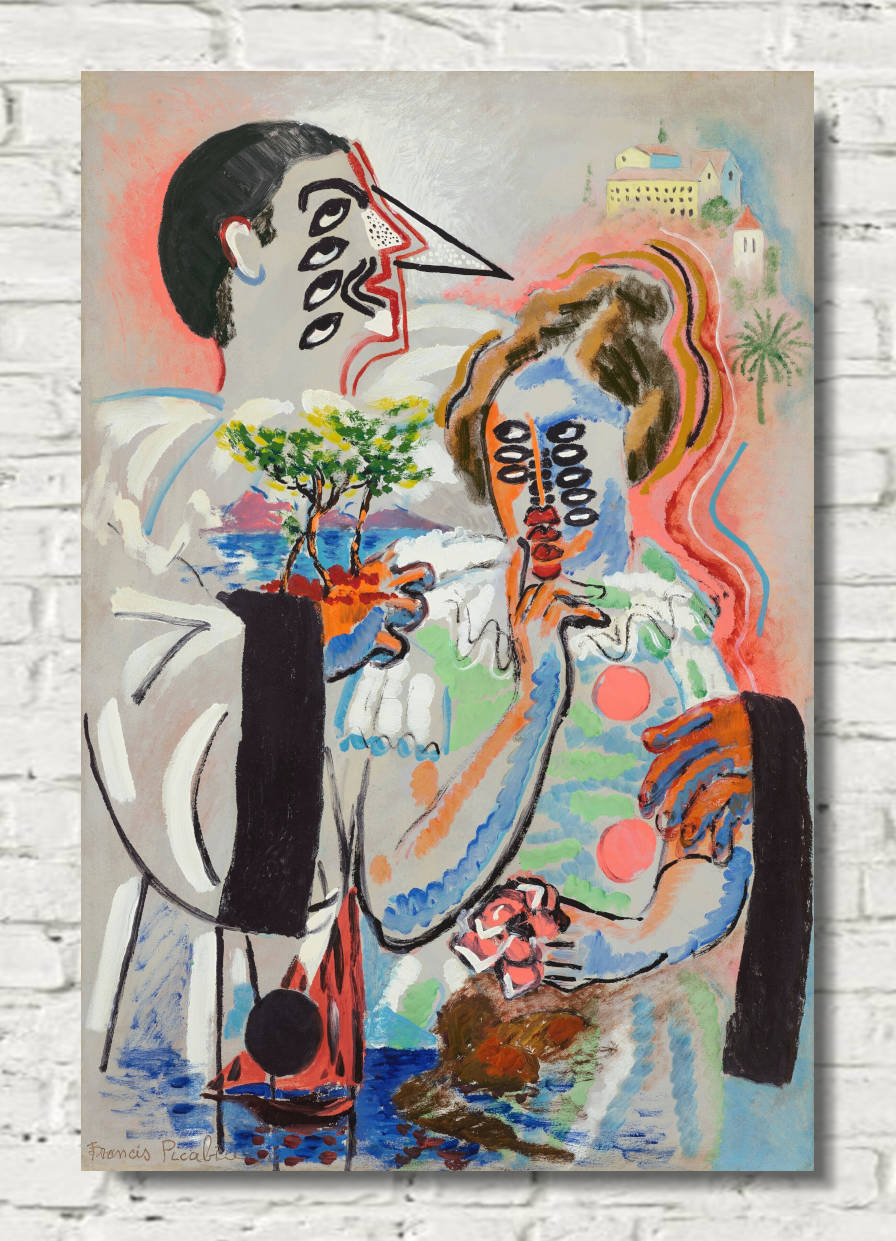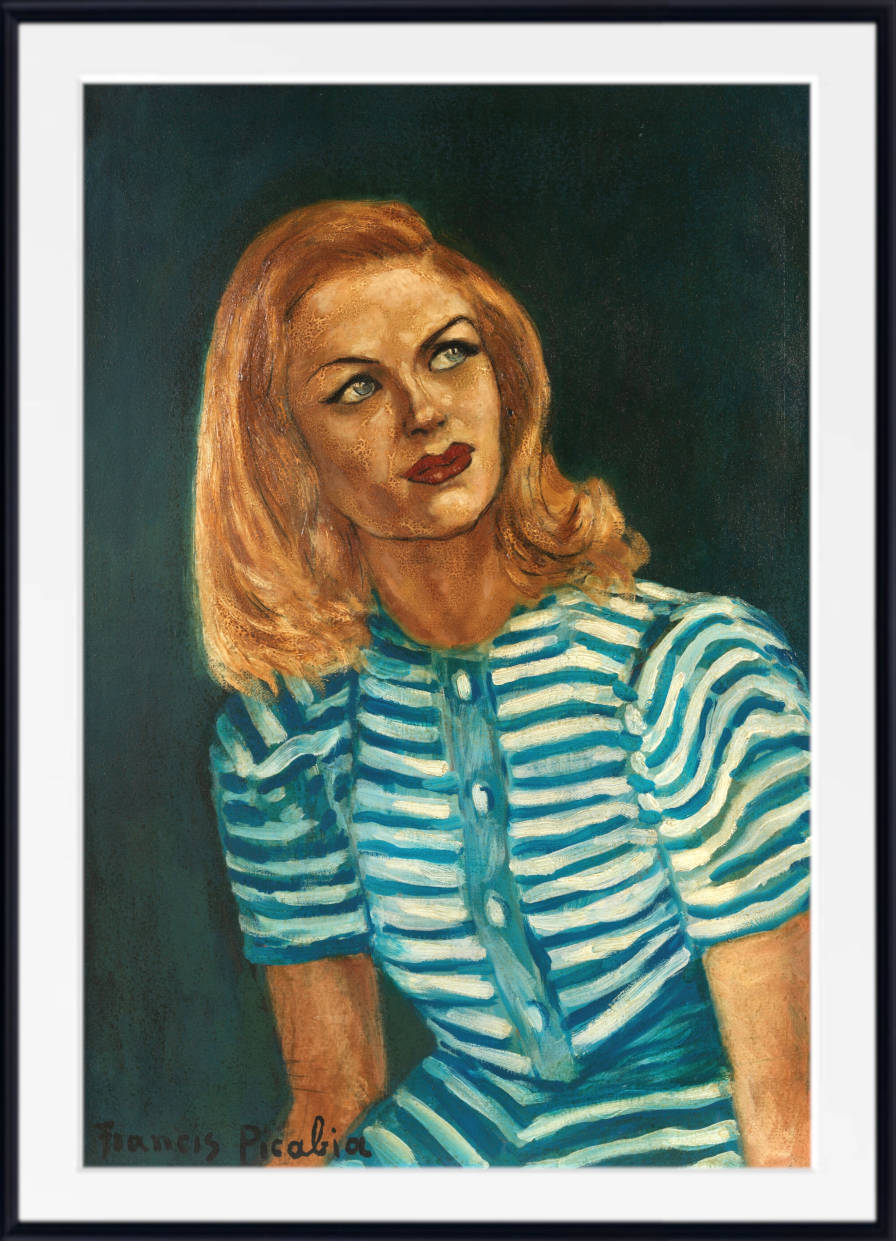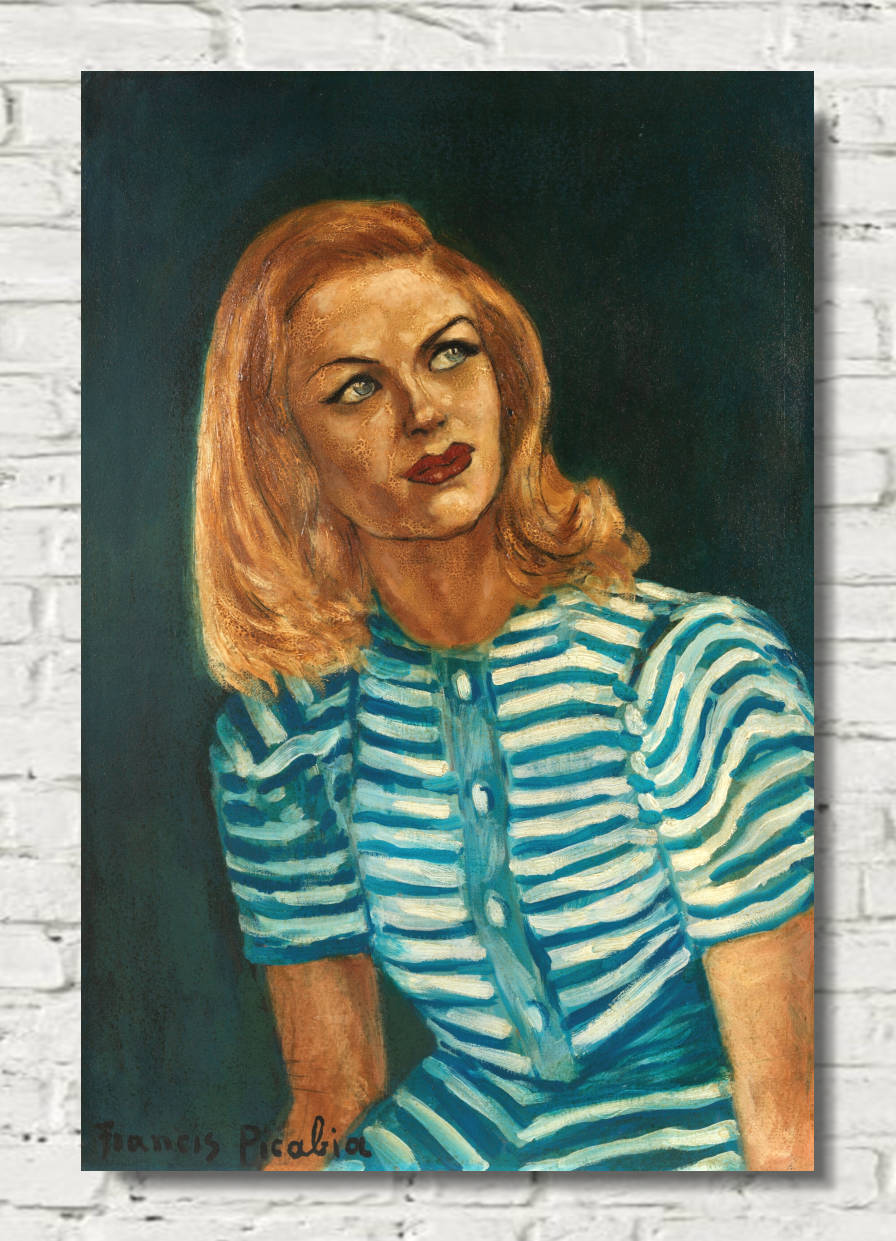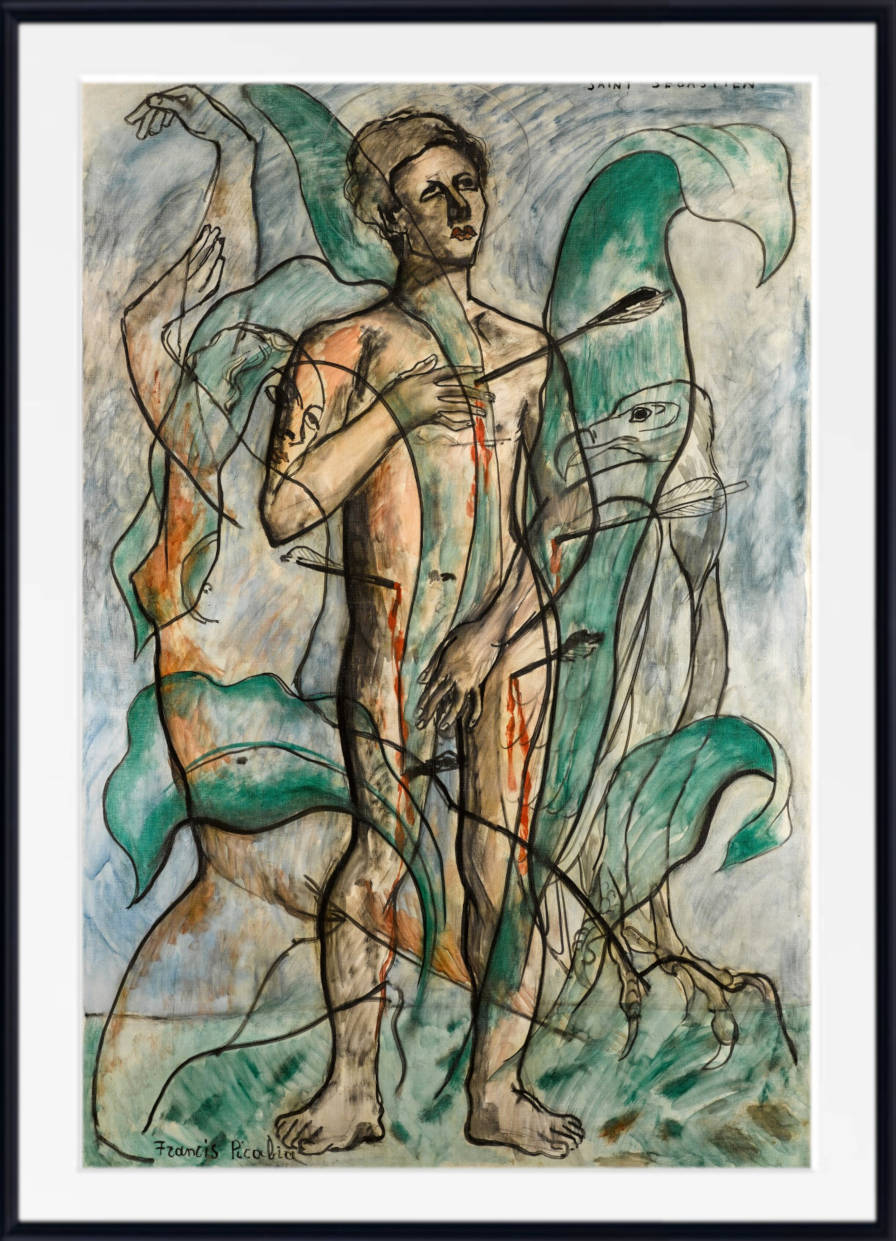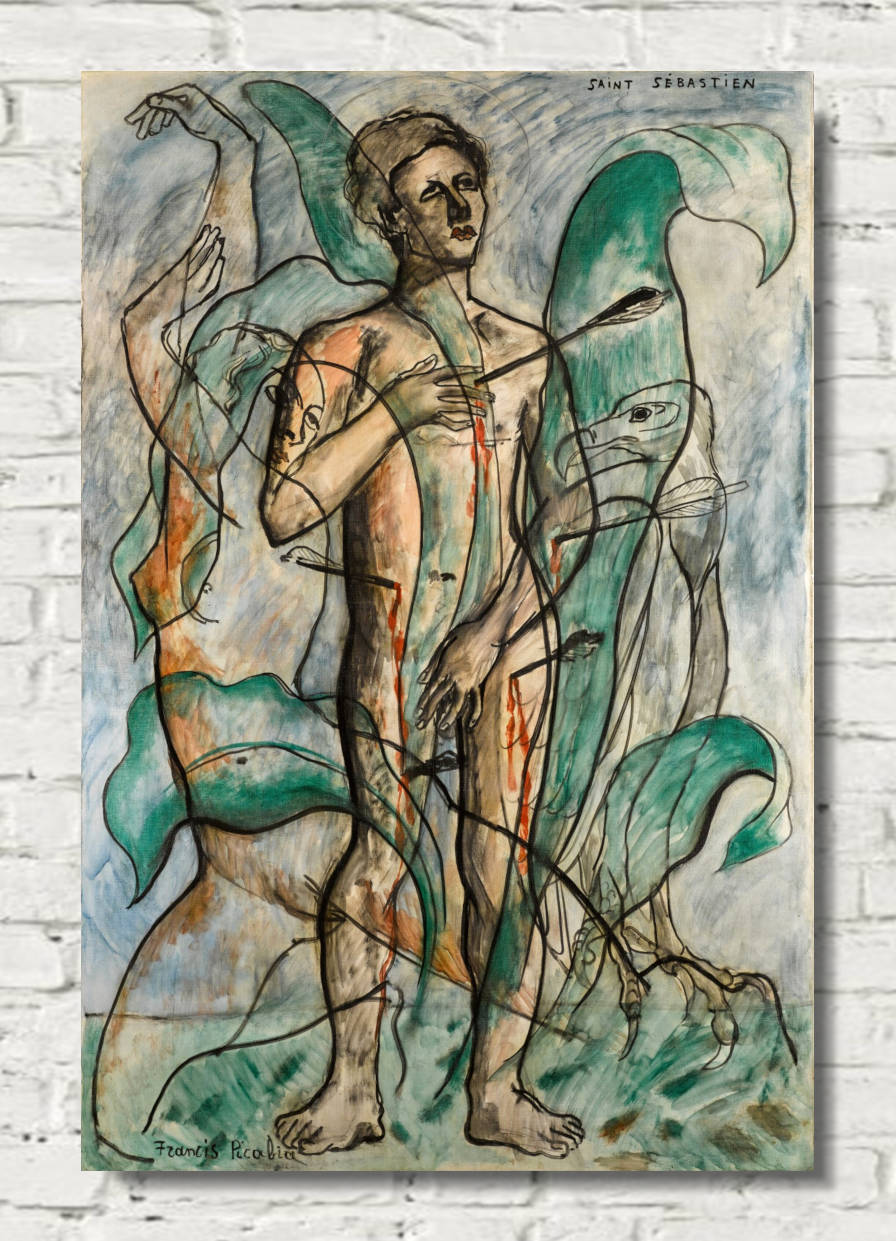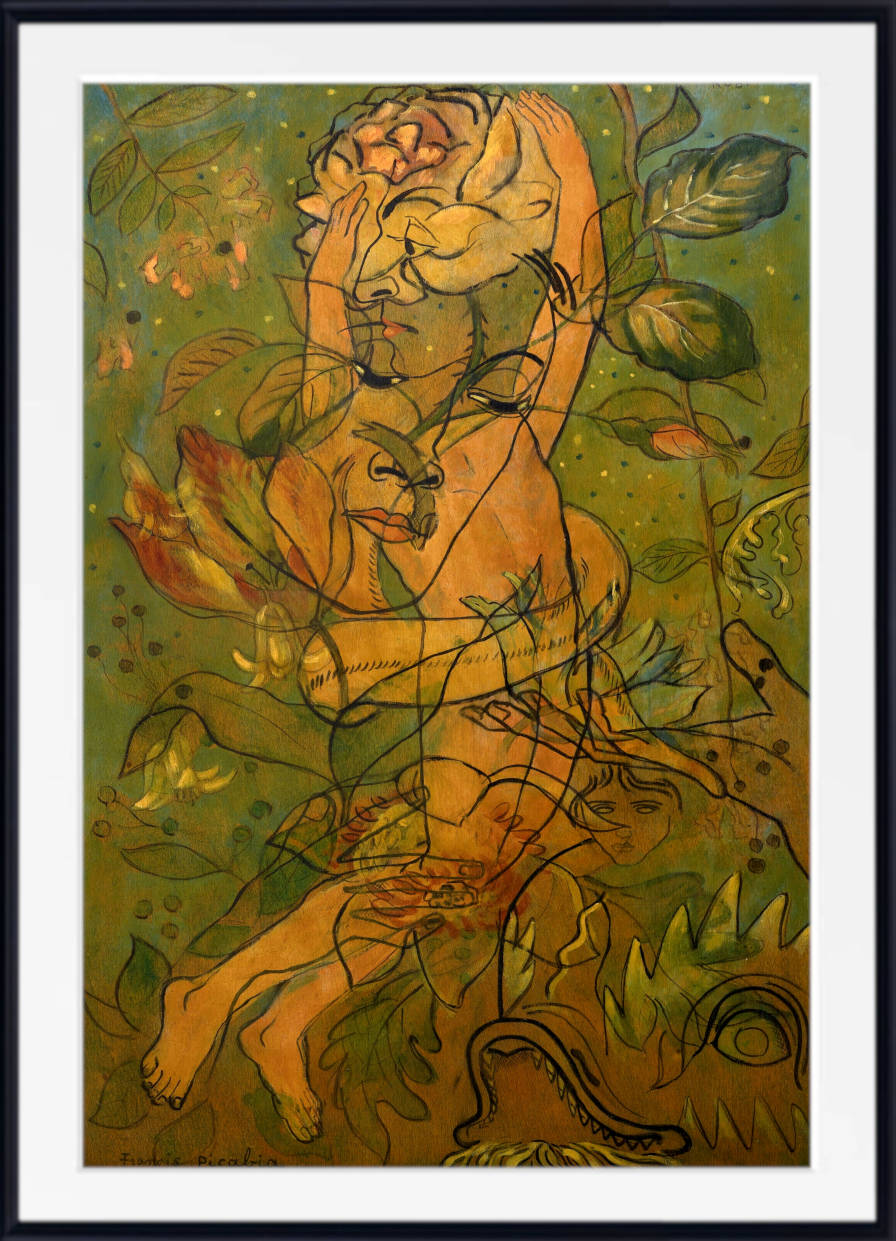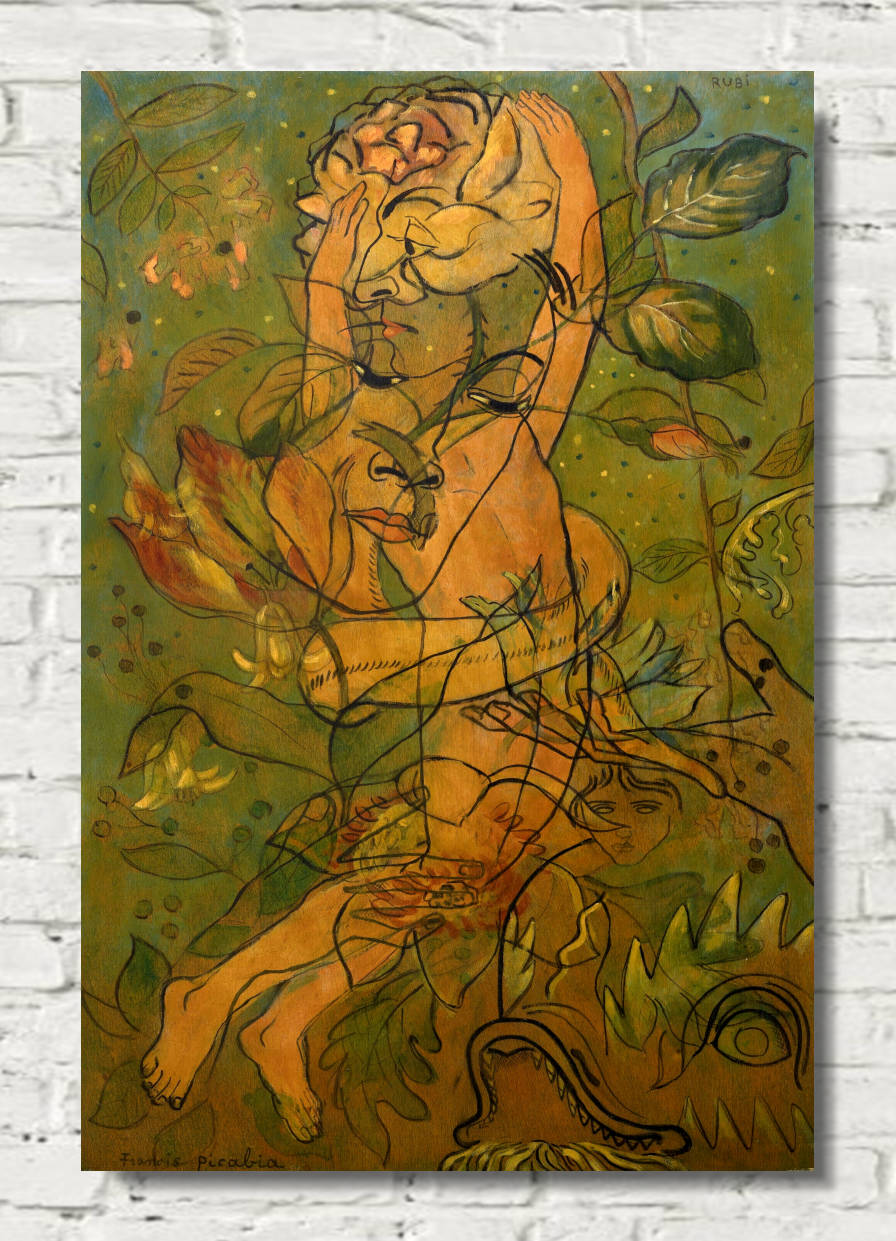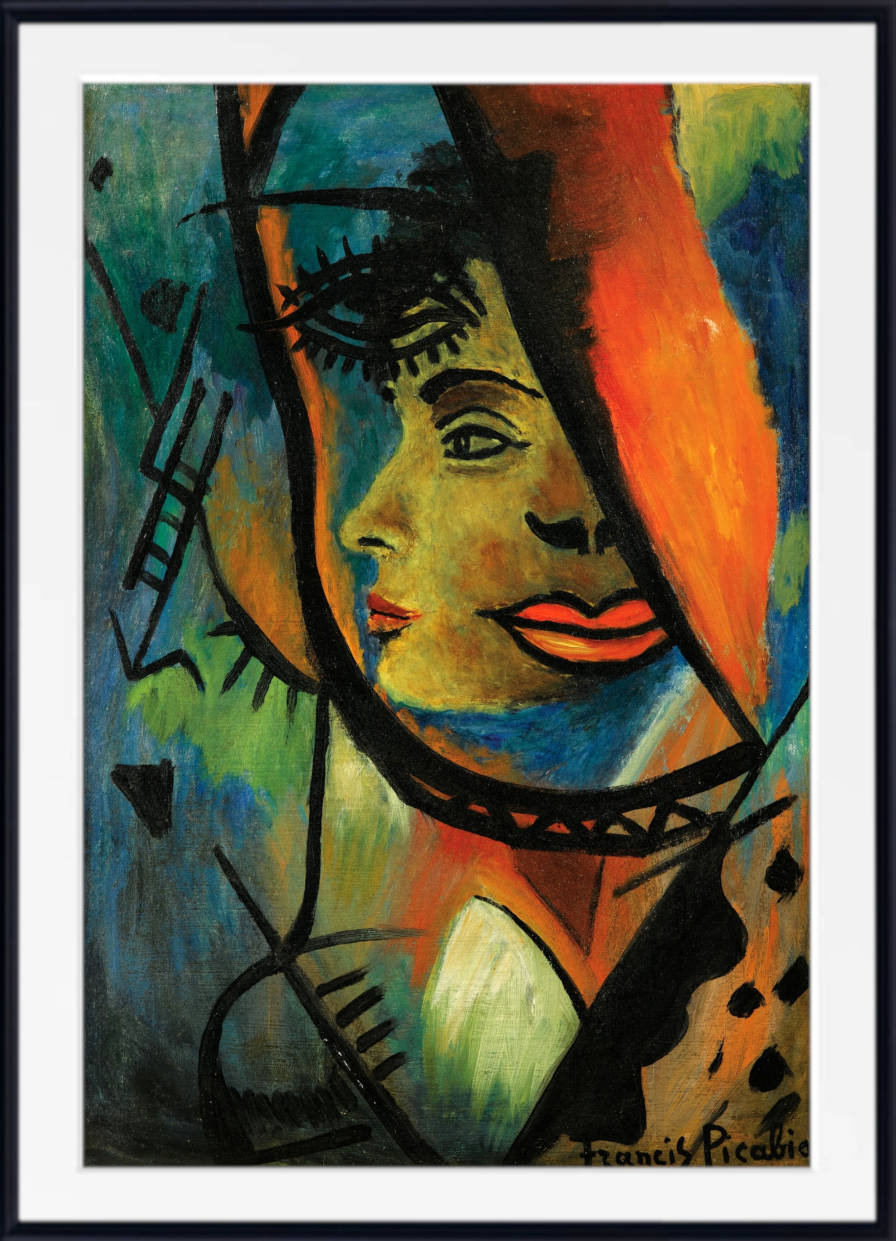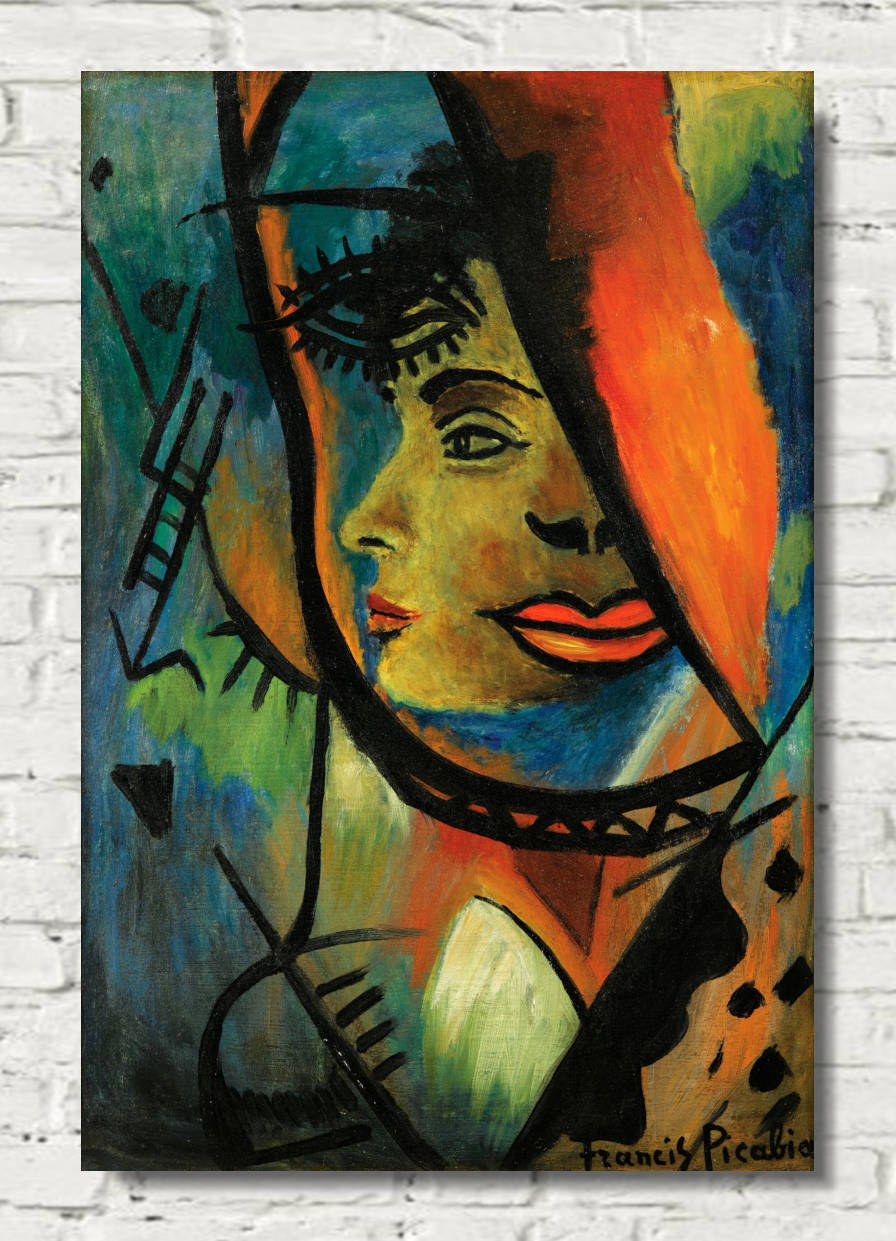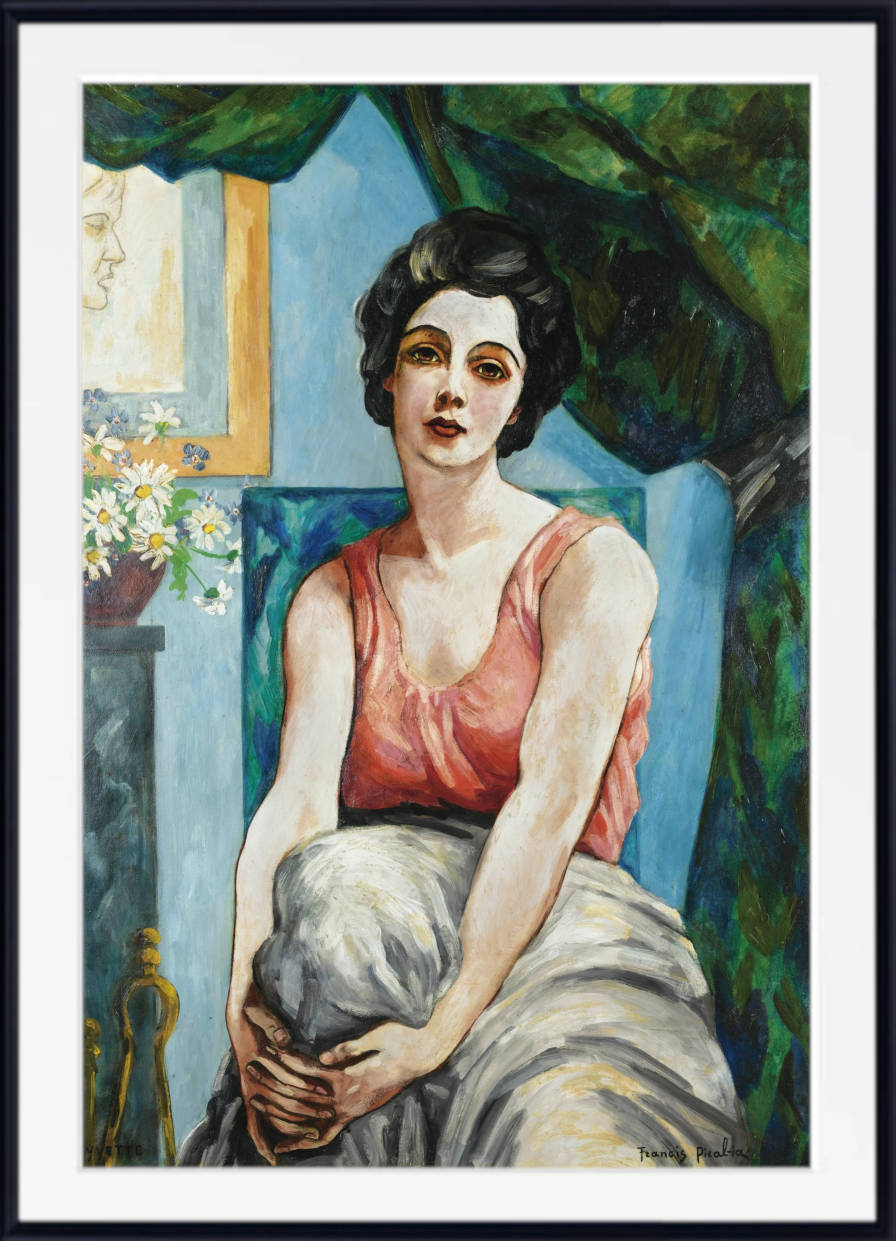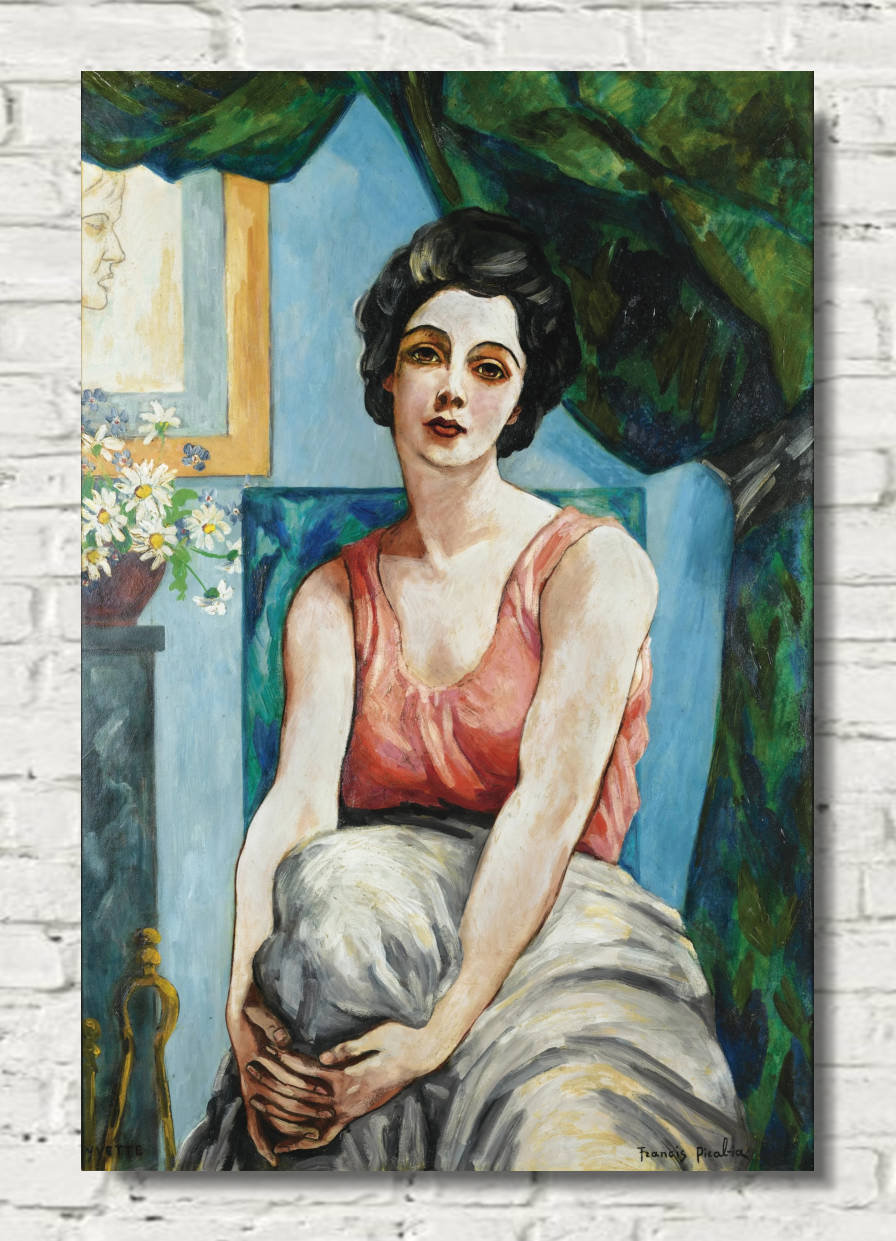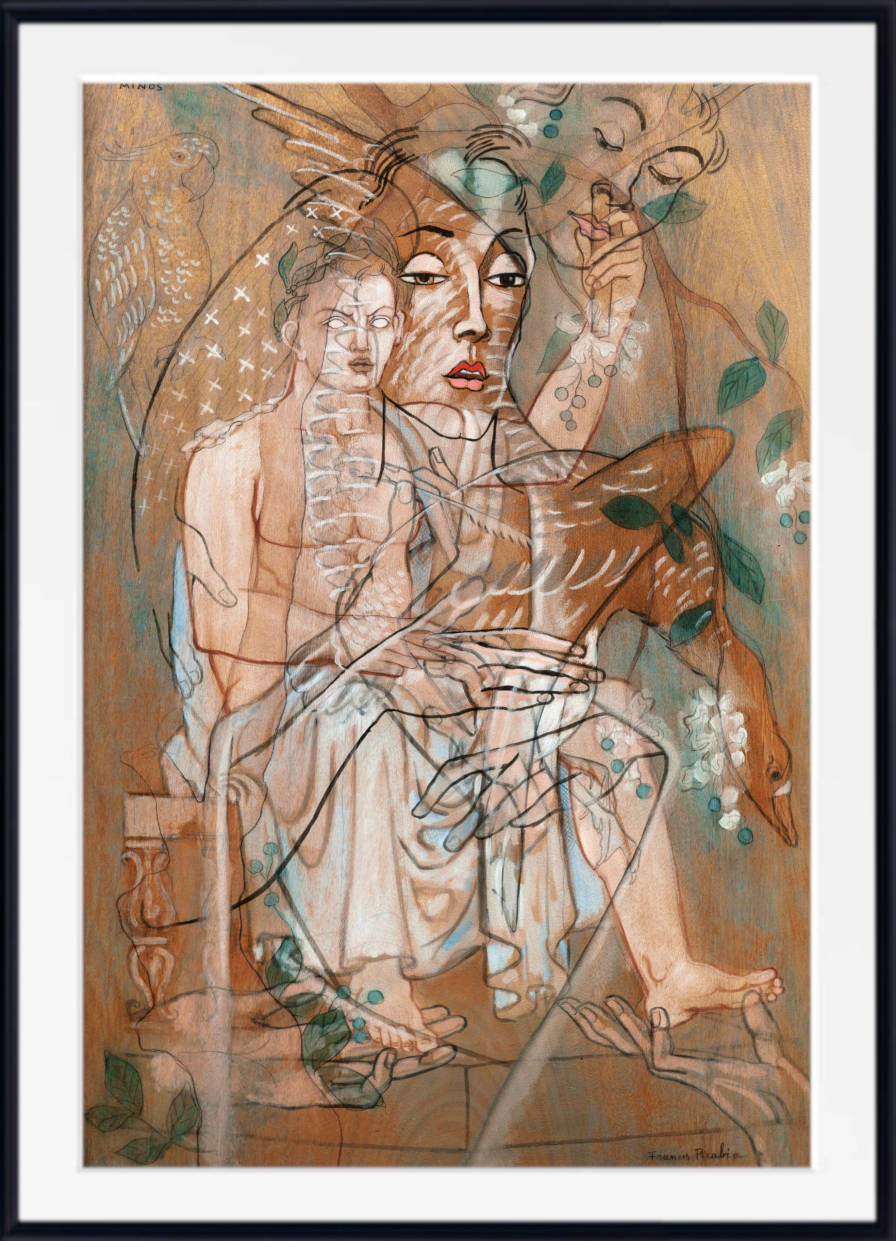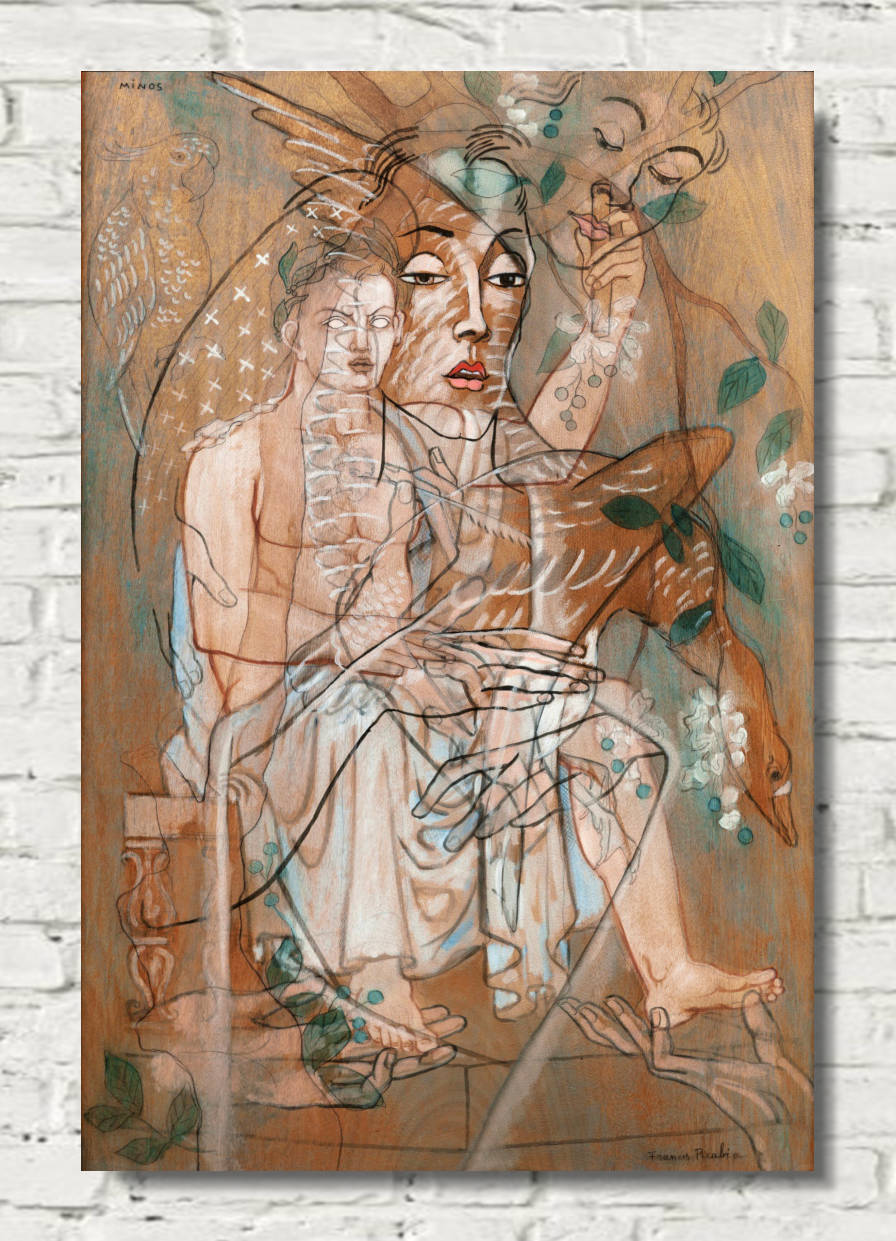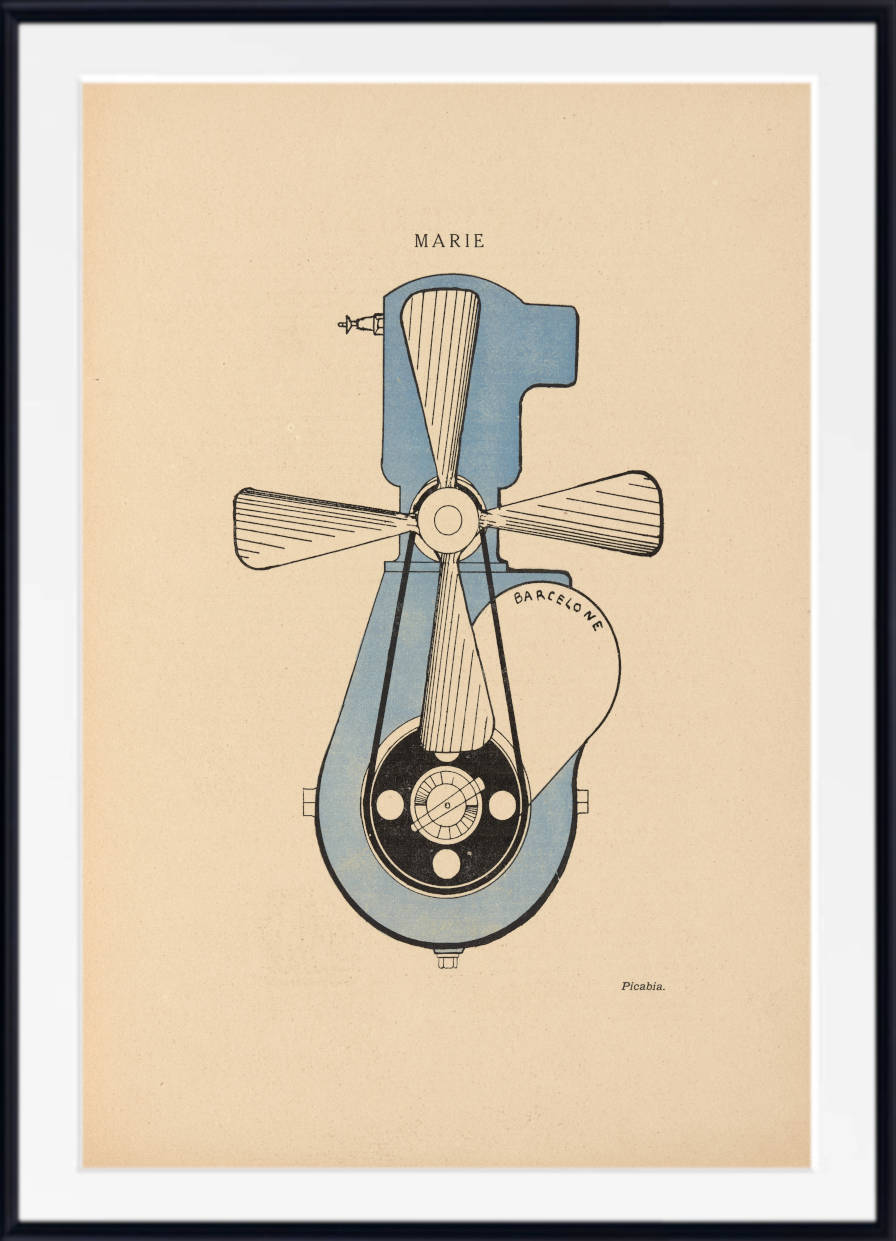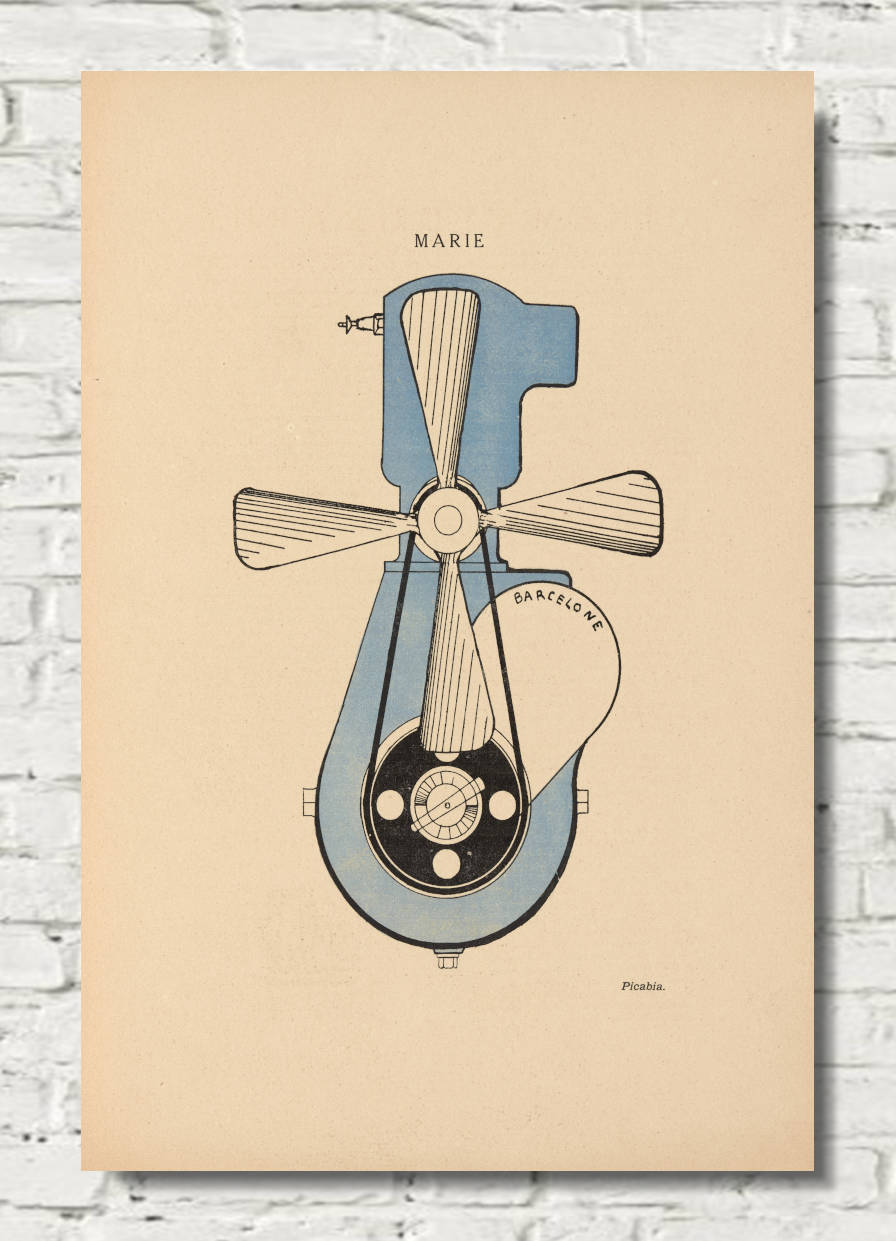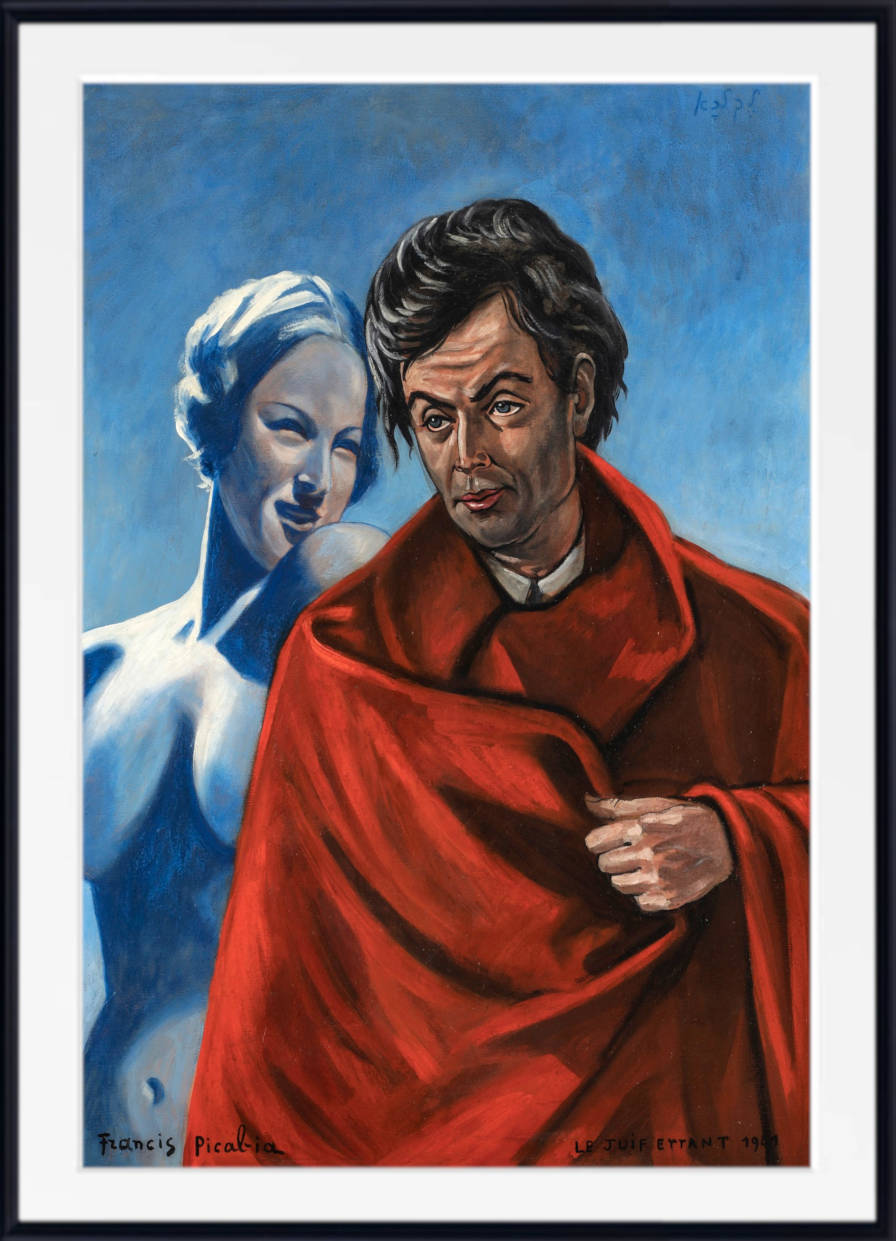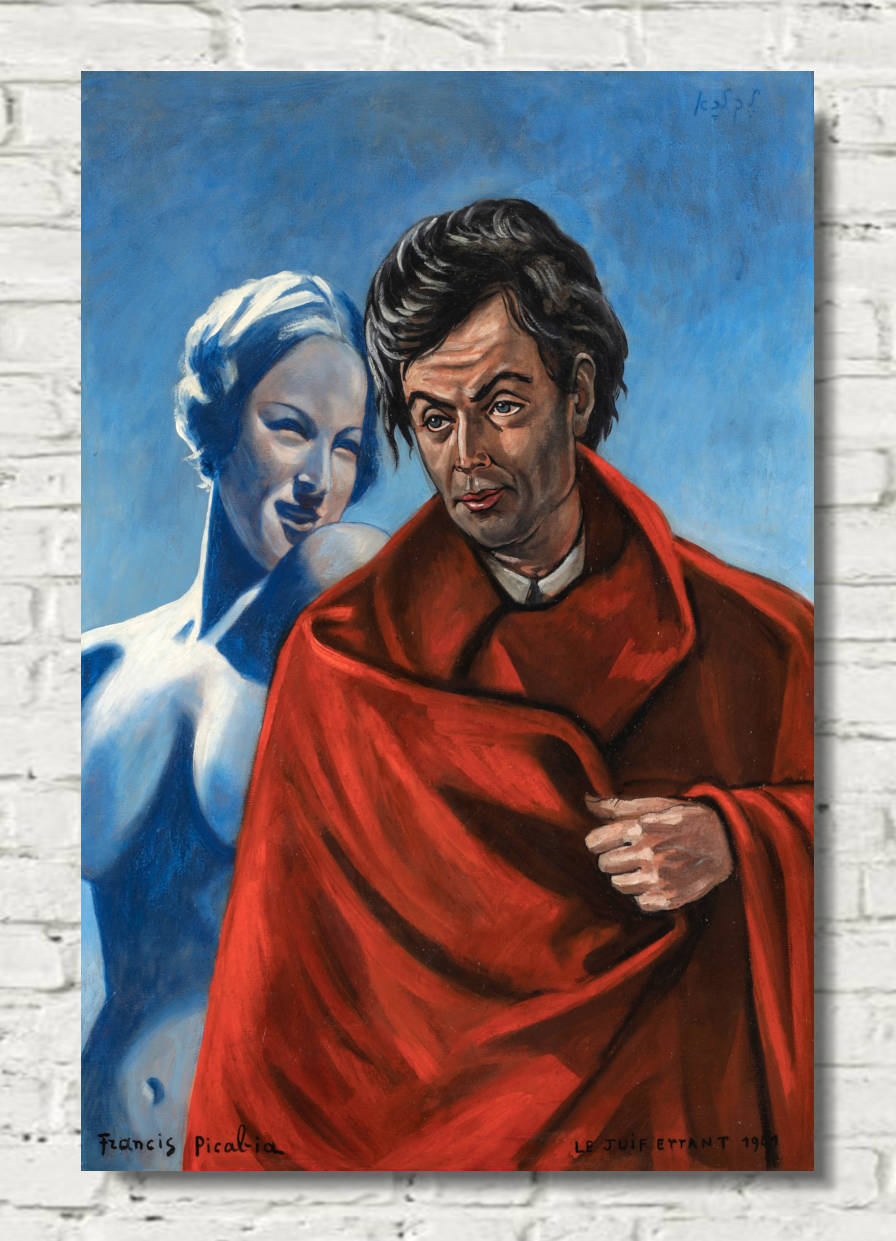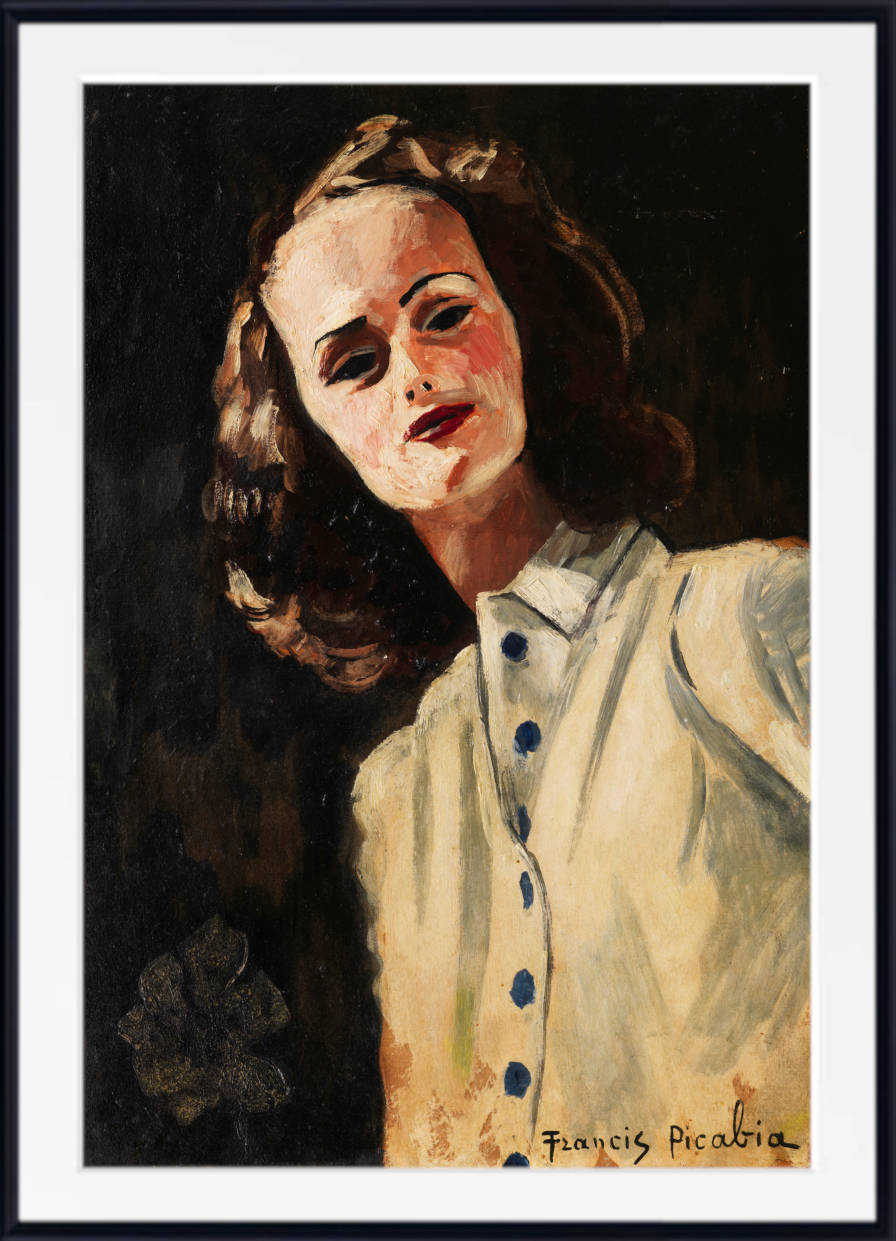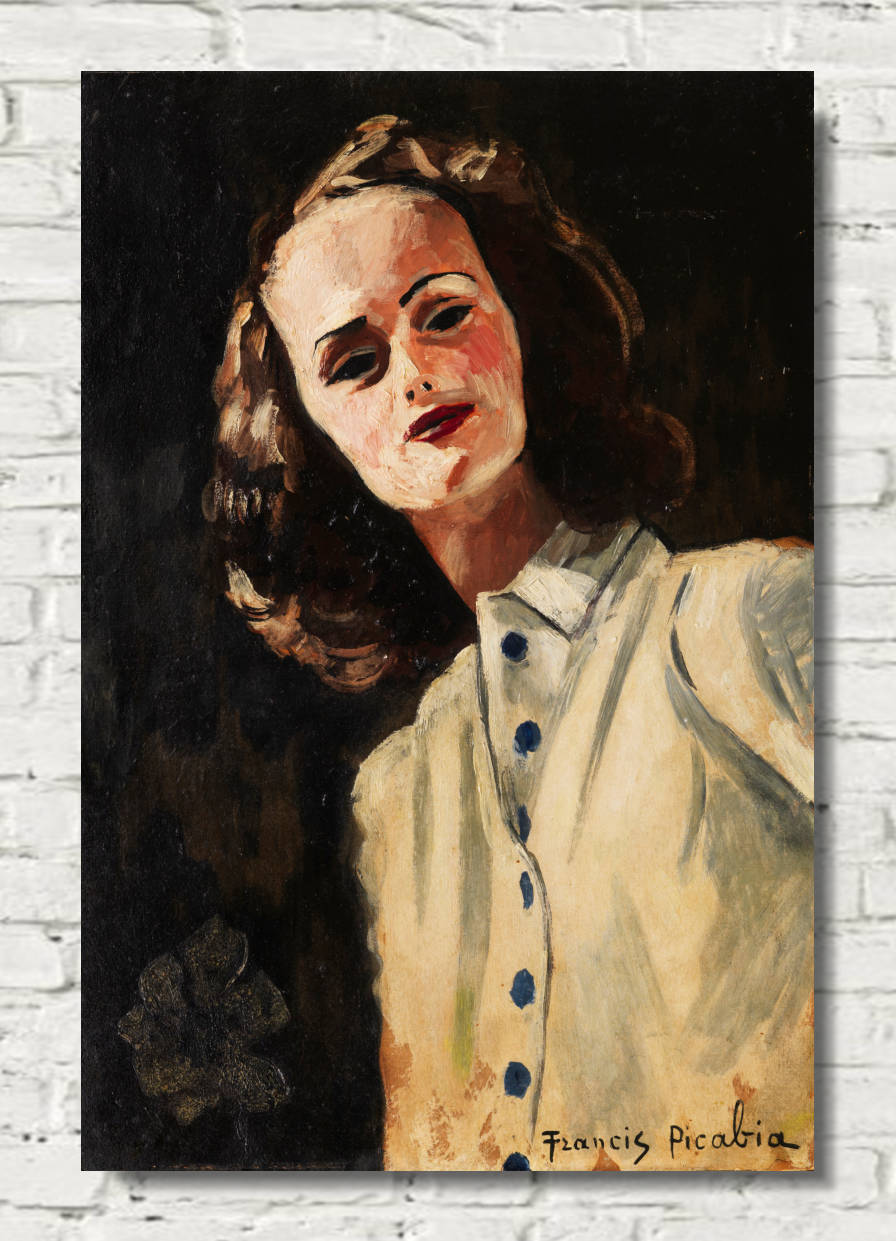Index, Francis Picabia
Once known as "Papa Dada," Francis Picabia was one of the principle figures of the Dada movement both in Paris and New York. A friend and associate of Marcel Duchamp, he became known for a rich variety of work ranging from strange, comic-erotic images of machine parts to text-based paintings that foreshadow aspects of Conceptual art. Even after Dada had been supplanted by other styles, the French painter and writer went on to explore a diverse and almost incoherent mix of styles. He shifted easily between abstraction and figuration at a time when artists clung steadfastly to one approach, and his gleeful disregard for the conventions of modern art encouraged some remarkable innovations even later in his career, from the layered Transparency series of the 1920s to the kitsch, erotic nudes of the early 1940s. Picabia remains revered by contemporary painters as one of the century's most intriguing and inscrutable artists.
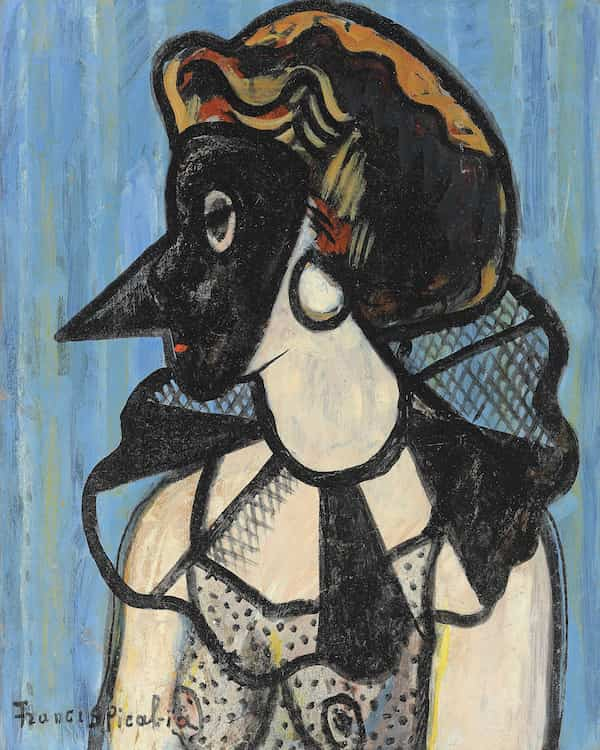
Masked Woman, Francis Picabia
Francis Picabia was born in 1879 in Paris, the only child of a Cuban-born Spaniard, Francisco Vicente Martinez Picabia, and a Frenchwoman, Marie Cecile Davanne. Both his parents came from prominent European families, and Picabia was raised in an affluent household. Throughout his life, the family fortune allowed him to study, travel, and enjoy a luxury lifestyle. However, at the age of seven, his mother passed away of tuberculosis, and the following year his grandmother died. These losses ensured that Picabia's childhood would be a lonely one, and he was left in the care of his father, the chancellor to the Cuban Embassy, his uncle, Maurice Davanne, a curator of the Bibliotheque Sainte Geneviève, and his maternal grandfather, Alphonse Davanne, a wealthy businessman. Their house was known as the house of quatre sans femmes (four without women). His uncle was an art lover and collector, who facilitated young Picabia's interests by surrounding him with works by classical French painters such as Fèlix Ziem and Ferdinand Roybert. His grandfather, a devoted amateur photographer, taught Picabia about photography, and Picabia would later use a camera to aid his work.
Early Career
In 1895, Picabia started attending the prestigious École des Arts Decoratifs, where recent alumni included Vincent van Gogh and Henri Toulouse-Lautrec. He studied under Fernand Cormon, Ferdinand Humbert, and Albert Charles Wallet for two years. He then worked at Cormon's studio with his classmates Georges Braque and Marie Laurencin for the next four years. During this time, he produced mostly watercolors and exhibited only once at the Salon des Artistes Francais. He quickly left painting traditional watercolors and transitioned towards Impressionism, influenced by Camille Pissarro and Alfred Sisley. He believed that "paintings should not represent nature, but the emotional experience of the artist," and that Impressionism was a tool to represent his ideals. Picabia held his first solo show in 1905 at the Galerie Hausmann in Paris. The show exhibited 61 landscape paintings and received substantial acclaim. After the show, he became widely popular in the art scene, showing solo in Paris, London, and Berlin. However, in 1909, he abandoned the style that brought him initial success and moved towards more avant-garde styles, including Fauvism. This caused a break with his representation at the Galerie Hausmann. In the same year, he married Gabrielle Buffet, a musician, who brought music into his life. Through her, he saw the possible link between art and music. She also encouraged his interest in more avant-garde styles. From 1909 to 1913, Picabia once again struggled to find the style best suited to express his developing concerns for the emotional and the intellectual, as well as the inner experience and the outer form. He jumped from one style to another, experimenting with Fauvism, Cubism, and abstract art. The attention from the art world that used to surround him decreased dramatically during his exploration. Despite his unstable prospects as an artist, Picabia and Gabrielle started a family, having their first child in 1910 and a second the following year. Picabia and Gabrielle joined the Sociètè Normande de Peinture Moderne, which met to foster and promote the theory of correspondance and the interdisciplinary relationship between all arts. It held annual exhibitions and other events, creating opportunities to network and socialize with other artists. In 1911, Picabia met Marcel Duchamp, beginning a long friendship that played a major role in both their lives and careers. Picabia also befriended the famous American writer Gertrude Stein who was supporting and spending time with modern artist in Paris. Stein tellingly said of him "that although he has in a sense not a painter's gift he has an idea that has been and will be of immense value to all time."
Mature Period
By 1912, Picabia shifted to the more radical style of Cubism, painting from his memories and experiences rather than drawing inspiration from nature. Showing at the seminal 1913 Armory Show in New York, he presented Danses à la source I (1912), Souvenir de Grimaldi (1912), La Procession Seville (1912), and Paris (1912). His works received mixed reviews, with some journalists dismissing his "color harmonies" as "a hoax." Despite the criticism in America, he overstayed his two-week visit and acquainted himself with Alfred Stieglitz and his Gallery 291. When World War I broke out, Picabia left France to seek refuge first in Barcelona, then in New York, and later in the Caribbean. The war pushed him to find yet another style that would represent the era of industrialization. He showed the first of his machine paintings, his mechanomorphs, in 1916 at the Modern Gallery in New York. His relationship with his wife began to fall apart when he met Germaine Everling in 1917. His mental and physical health deteriorated into depression. During his recuperation, Picabia shifted his focus from painting to writing. He published his poems in 1917 under the title Cinquante-deux miroirs (52 Mirrors) and began publishing a review, titled 391 after Stieglitz's 291 Gallery. 391 became Picabia's outlet for Dadaist writings and visual representation of its ideals, although he also contributed to other Dadaist publications, like André Breton's Litterature and the Dada revue, and published three volumes of poetry, Poèmes et dessins de la fille neé sans mère (1918), L'athlète des pompes funèbres (1918), and Rateliers platoniques (1918). In 1919, Picabia and Buffet officially separated. By this time, his machinist style paintings were already well known through the avant-garde publications. In 1920, Dada reached its peak and the visions of Dadaist "events", exhibitions, books, articles, and magazines became more defined. After years of promoting itself as a movement of anti-art, Picabia felt Dada had become just another system of established ideas. In 1921, he attacked other Dadaists in a special issue of 391, Phihaou-Thibaou. After the break from Dada, he focused on exhibiting his paintings again. And in 1922, he had a show at Salon d'Automne of his machinist paintings alongside more figurative pictures inspired by Spanish themes. After leaving his colleagues of the past ten years, and in the search of new life with his new common-law wife, he left Paris for the south of France in 1925 and stayed on the Cote d'Azur for twenty years. Germaine and Picabia settled into a home in Cannes and hired a governess for their son, Lorenzo. Picabia fell in love with the governess, Olga Mohler, and left Germaine soon after. They officially split in 1933.
Francis Picabia - Late Period
In 1928, Picabia presented his Transparency paintings at the Galerie Theophile Briant. Film critic Gaston Ravel called them "sur-impressionism" as the paintings were said to have the neo-romantic look of superimposed film images. The Transparency series received warm acclaims from his peers, especially Duchamp. His then art dealer, Leonce Rosenberg, described it as "the association of the visible and the invisible... It is this notion of time added to that of space which precisely constitutes the doctrine of your art. Beyond the instantaneity towards the infinite, such is your ideal." Remove Ads While living in Cannes he was quite the celebrity with the locals, receiving frequent visits from his famous friends, Jacques Douchet, Marthe Chenal, Pierre de Massot, and Marcel Duchamp. Picabia also enjoyed his wealth during this time, taking pleasure in throwing lavish parties, gambling, and collecting luxury cars and yachts. When World War II started in 1939, the devastation reached Picabia and his lifestyle became quite modest. For the first time in his life, his primary source of income was from the sale of his paintings. In 1940, Picabia and Olga Mohler married. As it did whenever a major event occurred in his life, his painting style transformed once again. Many say that his paintings from the 1940s were purely for commercial value. He painted popular imagery from "girlie" magazines of movie stars and romanticized couples in a realistic style. After the war, Picabia with briefly arrested by the French authorities for allegations that he was friendly with the Vichy (French Nazi) government during the war. He was release and never convicted but his reputation suffered, and Picabia never returned to France after 1945. There were various statements made by Picabia during the war that could be considered fascist, but as Picabia was ever the joking and anti-establishment personality, it is his hard to properly ascertain his position at that time. At the end of his long career, Picabia once again changed directions, painting in abstract forms. He continued to exhibit his work in prominent Parisian galleries and published his writings until 1951, when he suffered from arteriosclerosis and could no longer paint. Prior to his death in 1953, he referenced Nietzsche writing "Where art ends, where life begins, I am the poet of my life".
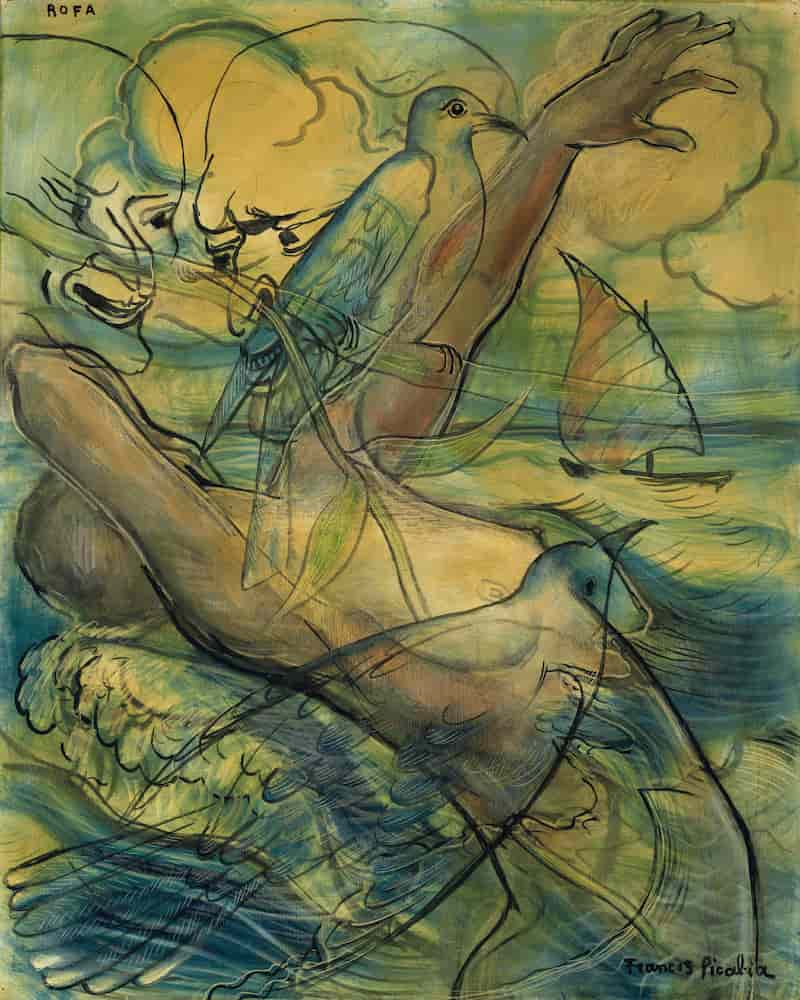
Rofa, Francis Picabia
Francis Picabia - The Legacy
Picabia did much to define Dada in Paris and New York, and his reputation as one of the movement's father figures has stayed with him. But it is perhaps the spirit that the movement encouraged in him - his anarchic spirit and his disrespect for conventional abstract modern art - that has yielded his greatest legacy. It is this spirit that shaped the Transparency series of the 1920s and the erotic nudes of the 1940s, both of which have proved hugely influential - the former on artists such as David Salle and Sigmar Polke, the latter on figures such as John Currin. When many artists thought abstract and figurative art should be separated, Picabia seemed to combine them. When others felt that the nude should remain a noble subject, he debased it. Picabia seems to have had a light-hearted and often cynical attitude to art-making, and while this put him at odds with many of his more serious peers, it is this attitude that seems so resonant to contemporary artists who not only have less faith in art's ability to change the world, but also have an attitude to museums and galleries that sways between the tolerant and the skeptical.

Visage de femme, Francis Picabia
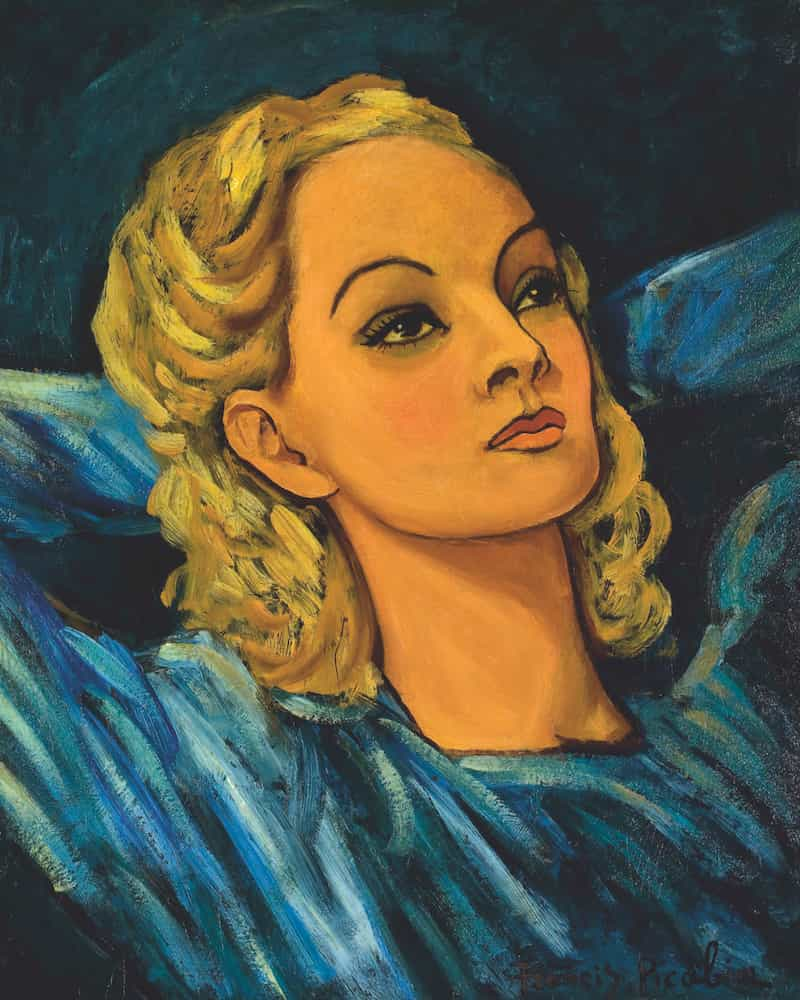
Portrait of a Blond, Francis Picabia
Francis Picabia Quotes
- Art must be unaesthetic in the extreme, useless and impossible to justify.
- The world is divided into two categories: failures and unknowns.
- The devil follows me day and night because he is afraid to be alone.
- If you want to have clean ideas, change them as often as your shirts.
- Dada talks with you, it is everything, it includes everything, it belongs to all religions, can be neither victory nor defeat, it lives in space and not in time.
- My ass contemplates those who talk behind my back.
- God invented concubinage, Satan marriage.
- A free spirit takes liberties even with liberty itself.
- Dada is like your hopes: nothing like your paradise: nothing like your idols: nothing like your heroes: nothing like your artists: nothing like your religions: nothing
- You are always looking for already-felt emotions, just as you like to get an old pair of trousers back from the cleaners, which seem new when you don't look too closely. Artists are cleaners, don't let yourself be taken in by them. True modern works of art are made not by artists but quite simply by men.
- One must go through life, be it red or blue, stark naked and accompanied by the music of a subtle fisherman, prepared at all times for a celebration.
- Pain has its reasons, pleasure is totally indifferent.
- Every page must explode, whether through seriousness, profundity, turbulence, nausea, the new, the eternal, annihilating nonsense, enthusiasm for principles, or the way it is printed.
- Maybe men are separated from each other only by the degree of their misery
- We are not responsible for what we do; we are ignorant of our acts until we accomplish them.
- A new gadget that lasts only five minutes is worth more than an immortal work that bores everyone.
- Knowledge is ancient error reflecting on its youth.
- New York is the cubist, the futurist city. It expresses in its architecture, its life, its spirit, the modern thought.
- Let us never forget that the greatest man is never more than an animal disguised as a god.
- Good taste is as tiring as good company.
- Nature is unfair? So much the better, inequality is the only bearable thing, the monotony of equality can only lead us to boredom.
- All beliefs are bald ideas.
- The future is a monotonous instrument
- Between my head and my hand, there is always the face of death.
- The only way to win is to fight on the side of your adversaries.

